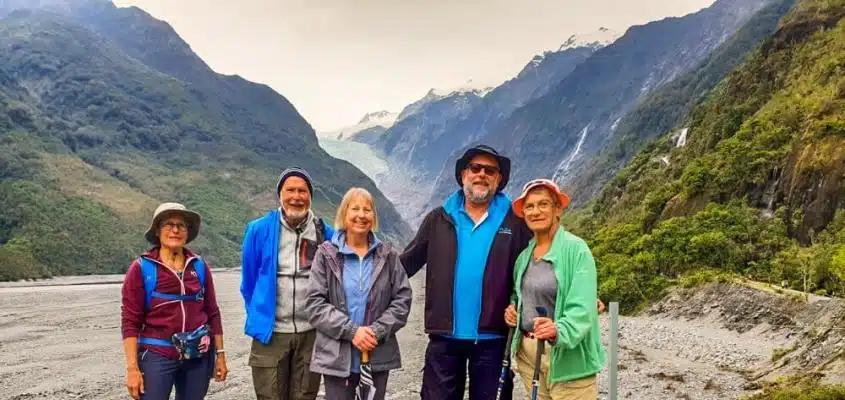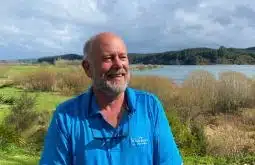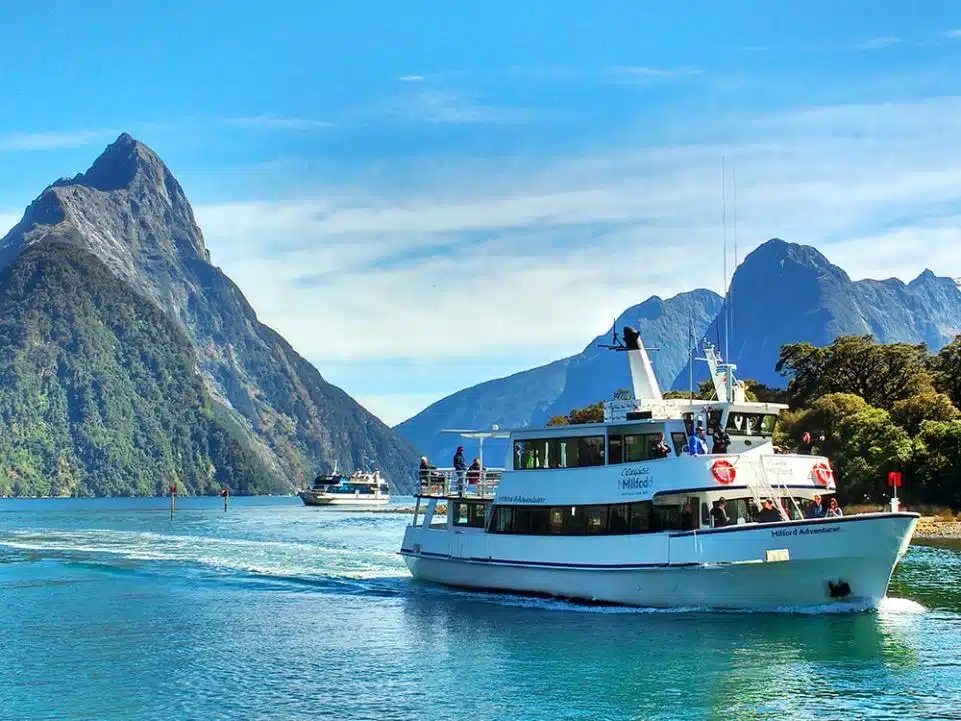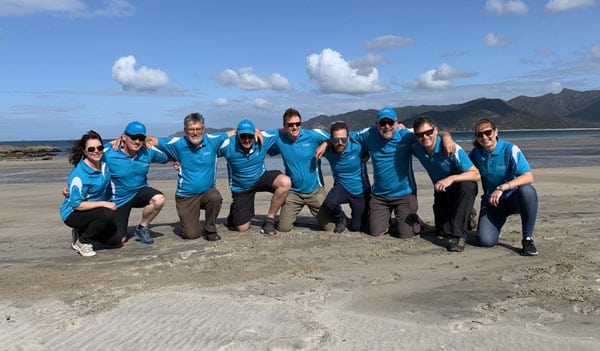MoaTrek Kiwi Guide Tim loves guiding tours around the South Island and shares his favourite spots and stories from recent trips around the southern half of the South Island visiting Aoraki/Mt Cook, Queenstown, Milford Sound, Wanaka, Franz Josef and Punakaiki.
Find out why after 25 years guiding it’s still his favourite part of New Zealand.
MoaTrek Kiwi Guide Tim and his favourite Kea
I’m so privileged to have spent the last 25 years showing travellers from New Zealand and the world around our amazing country. I have guided tours all over New Zealand and yet if you ask me where I like guiding most of all I will always say the southern half of the South Island.
The scenery is breathtaking and constantly changing (every time I travel in this area, I see something new), we stay in amazing locations, the food is great, and as we travel through 2.6 million hectares of UNESCO World Heritage protected forests and mountains, we see some rare and beautiful native wildlife.
Most of all I love introducing my fellow travellers to the good friends around the South Island I have made over the years and, believe me, some of them are real characters! This is the diary of my recent trip around the bottom of the South, read on and enjoy.
Day 1 – Christchurch – Akaunui Homestead – Aoraki/Mount Cook
The first day of a tour is always exciting, knowing that a group of strangers are going to end up as a “whānau” or family after the next nine days of travel and sharing new experiences together. With everyone safely on board, we set off towards our first stop, a home hosted lunch with Diana and Ian Mackenzie at Akaunui Homestead, just south of Ashburton.
This visit typifies what our tours are all about, Ian and Di are old family friends of MoaTours founder, Ena Hutchinson. They are third generation Canterbury farmers with a large property and invite us into their beautiful homestead and gardens. Di and Ian are the consummate hosts who do this because they love it and enjoy meeting people. As we shared a delicious meal straight from Di’s magnificent garden, they also became friends with everybody in our group, conversation and wine flowed (and often the conversation was about wine as Ian is an expert)!
This visit is an absolute highlight and a great way to start a tour, but it does provide me with some problems. Di has the amazing ability to remember people’s names on first introduction and she puts me to shame, as it takes me a bit longer to remember everyone’s names on the first morning of our tour. The other problem is getting people to leave, we do have an itinerary to follow and some distance to travel and it takes some time to get everybody on board as nobody wants this experience to end.
Finally, we are on the road with the rest of the day including learning about James Mackenzie, (no relation to Ian although I could see him as a sheep rustler back in the day), as we passed through the beautiful region that carries his name. We visited the Church of the Good Shepherd and enjoyed the spectacular views at Tekapo, Lake Pukaki and on the road to Aoraki/Mount Cook, where our exciting first day ended. On this trip we were lucky to have a crystal-clear night so the vista as we dined, while the sun set behind Mount Cook, was absolutely spectacular.
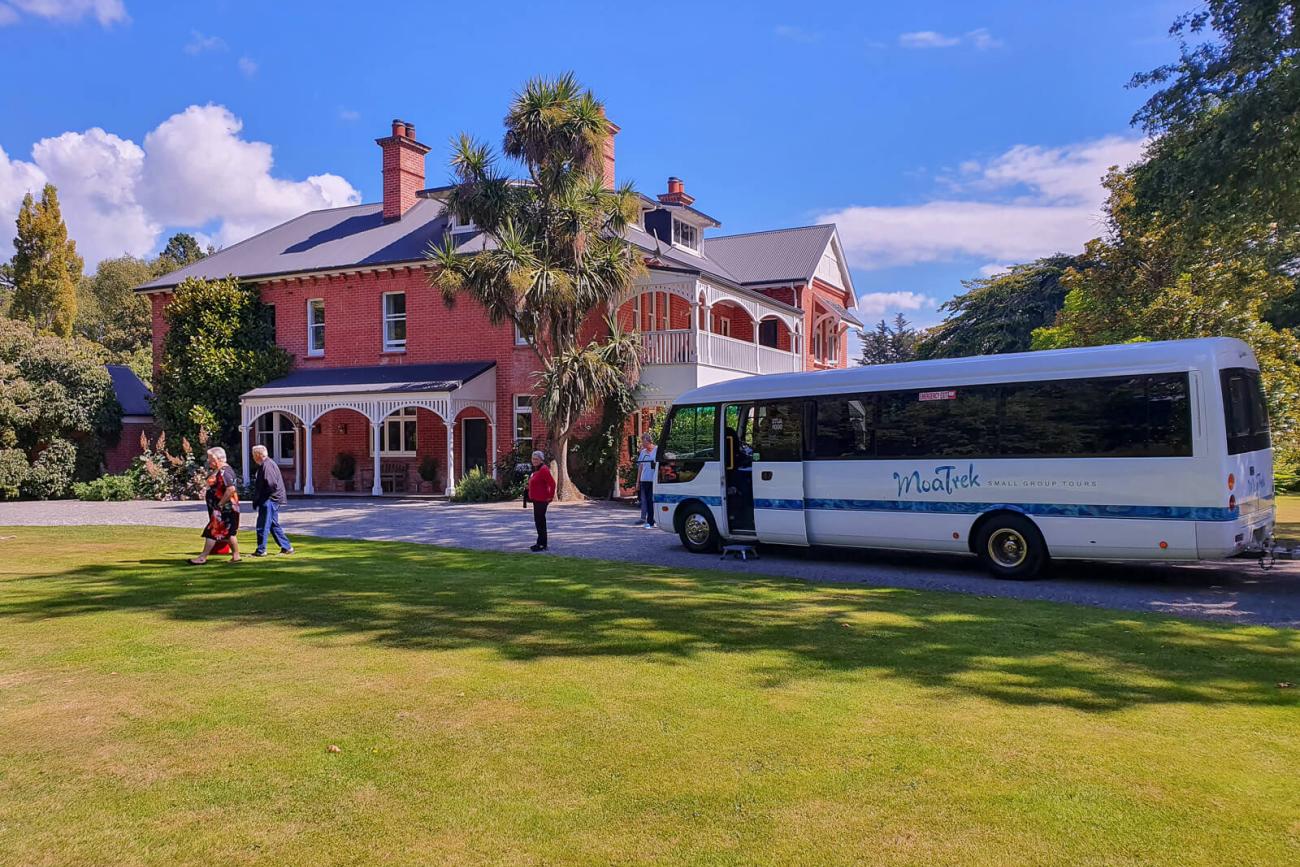
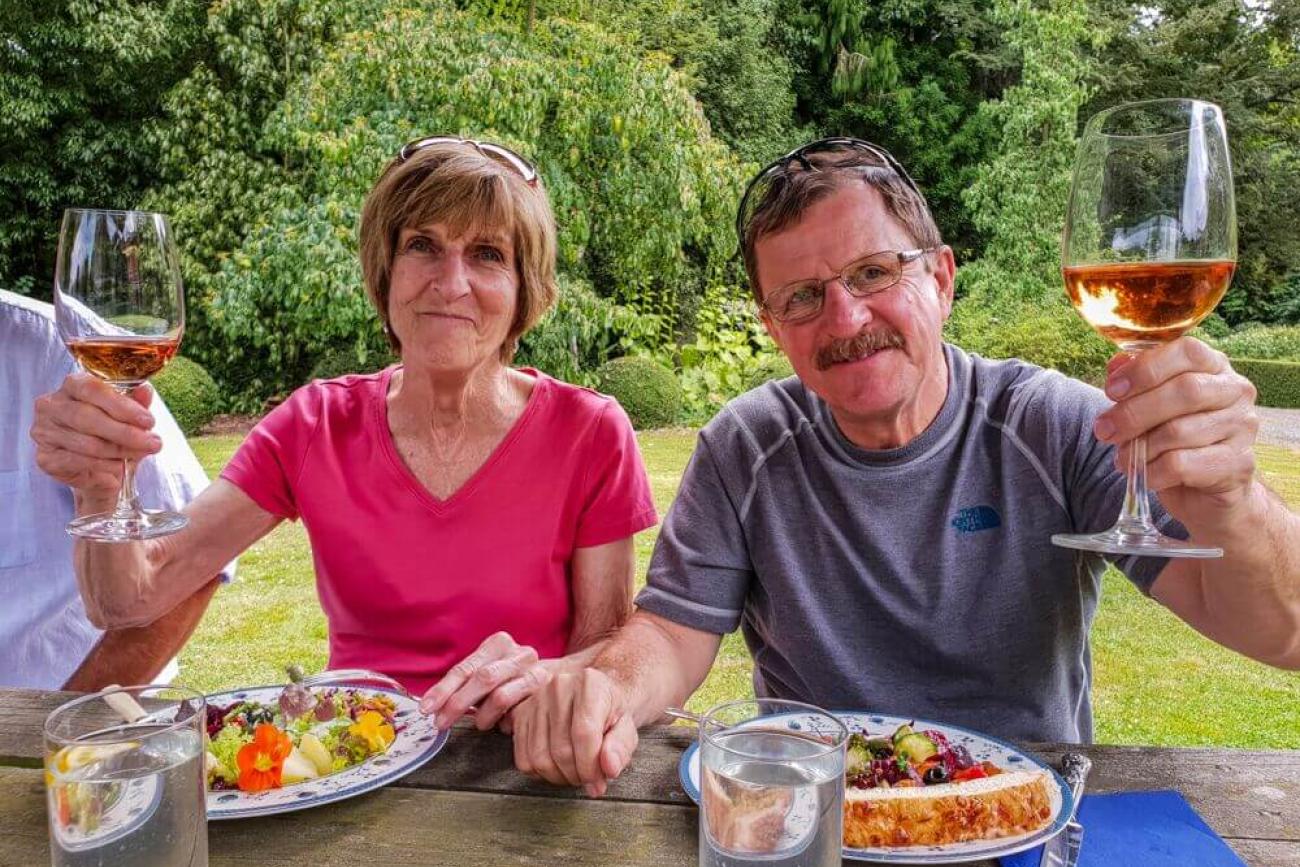
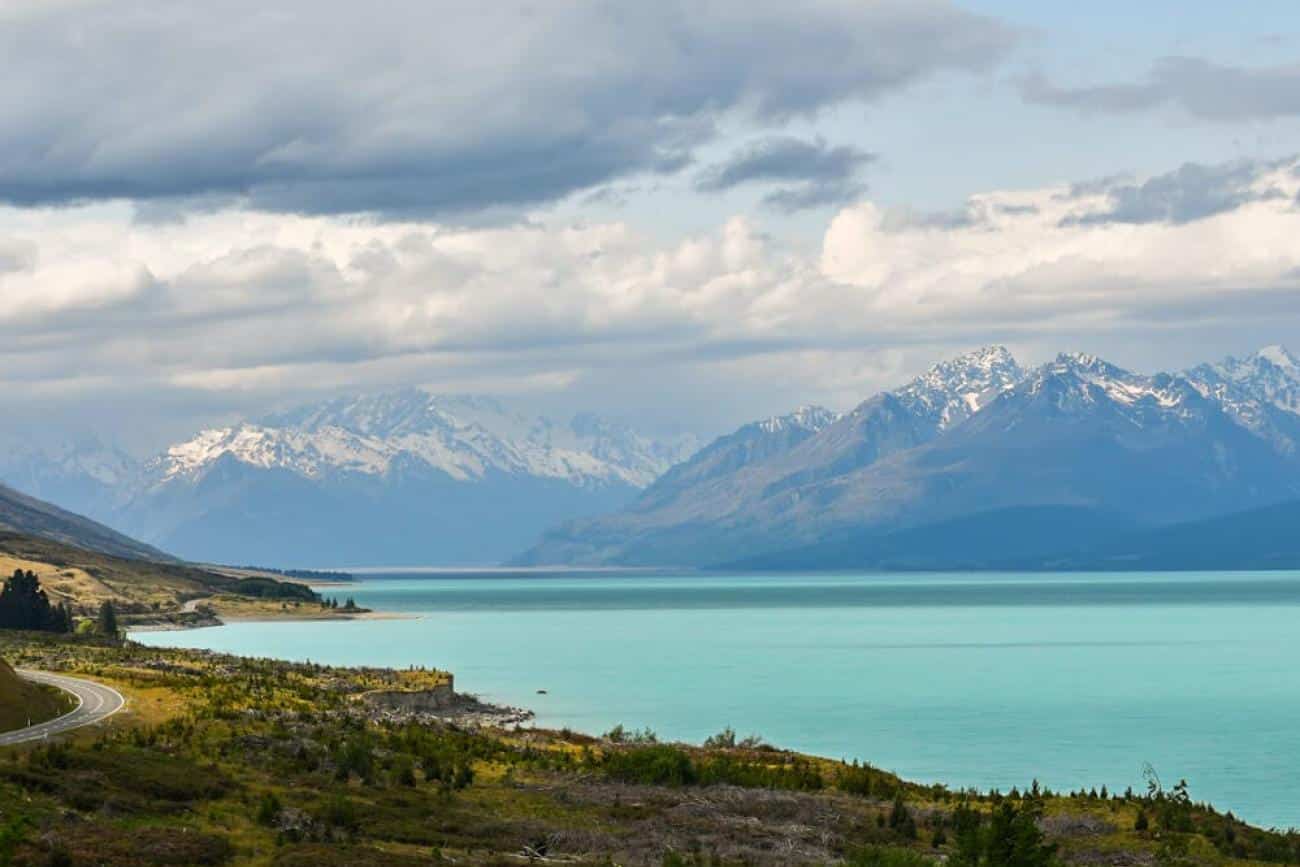
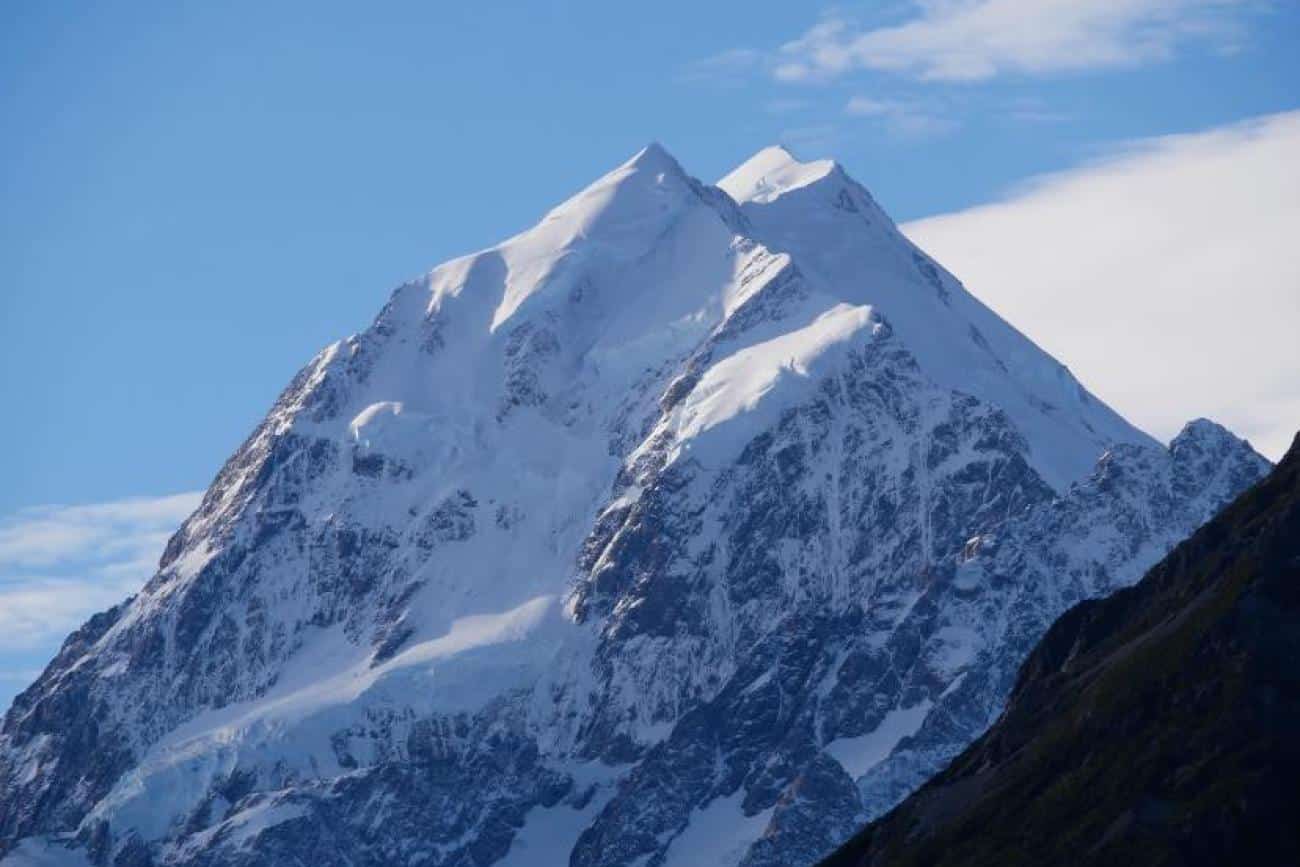
Day 2 – Aoraki/Mount Cook – Queenstown
After three great meals in the last 24 hours, including a gourmet breakfast at the Alpine Restaurant in the Hermitage, we were all in need of some exercise and the itinerary this morning provided an opportunity to walk among the majestic mountains of the Aoraki/Mount Cook National Park.
Some folk chose to do the relaxing short nature walks (Bowen and Governors Bush walks) in the vicinity of the Hermitage and then enjoy the views from the café, combined with a visit to the informative Sir Edmund Hillary Alpine Centre. The rest of the group did the Kea Point walkway which took them to stunning views of Mount Sefton, The Footstool, Hooker Valley, Mueller Glacier lake and New Zealand’s highest peak, Aoraki/Mount Cook. This easy walk has a height gain of 180m over three kilometres as it passes through subalpine grasslands to the viewpoint at the Mueller Glacier moraine wall. My companions chose from one of two options, a one hour, or two hour walk, thanks to the assistance of the MoaTours waka (bus) for drop offs and pick ups.
Late morning, we gathered at the Hermitage to continue our journey through Central Otago to Queenstown. Aoraki/Mount Cook receded from view behind us as we travelled alongside the turquoise coloured Lake Pukaki. We passed through Twizel with its history as a booming Hydro construction town (followed by a demise and then a rebirth), lunched in Omarama where we were able to get up close and personal with Merino Sheep and stopped at Tarras to learn of the impact of “Shrek the Sheep” on this small village and the local school.
I had some keen photographers on board, so en route, a stop at the Lindis Pass lookout was a must. The stark, tussock-grass clad mountain scenery is constant, but ever changing with the seasons. We were treated to a dry barren landscape highlighted by the vibrant colours of the autumn leaves. Winter provides snow-capped peaks, for a short period in spring the region is covered in the lush greens of pasture growth and in summer the wild lupin flowers provide an amazing display.
After one more scenic highlight, the barren and rugged Kawarau River gorge with its history of alluvial gold mining, a wonderful day of exploration ended as we arrived into Queenstown, checked into our hotel and went out to explore the town. Over dinner I had the pleasure of telling the crew – “tomorrow, it gets even better”!
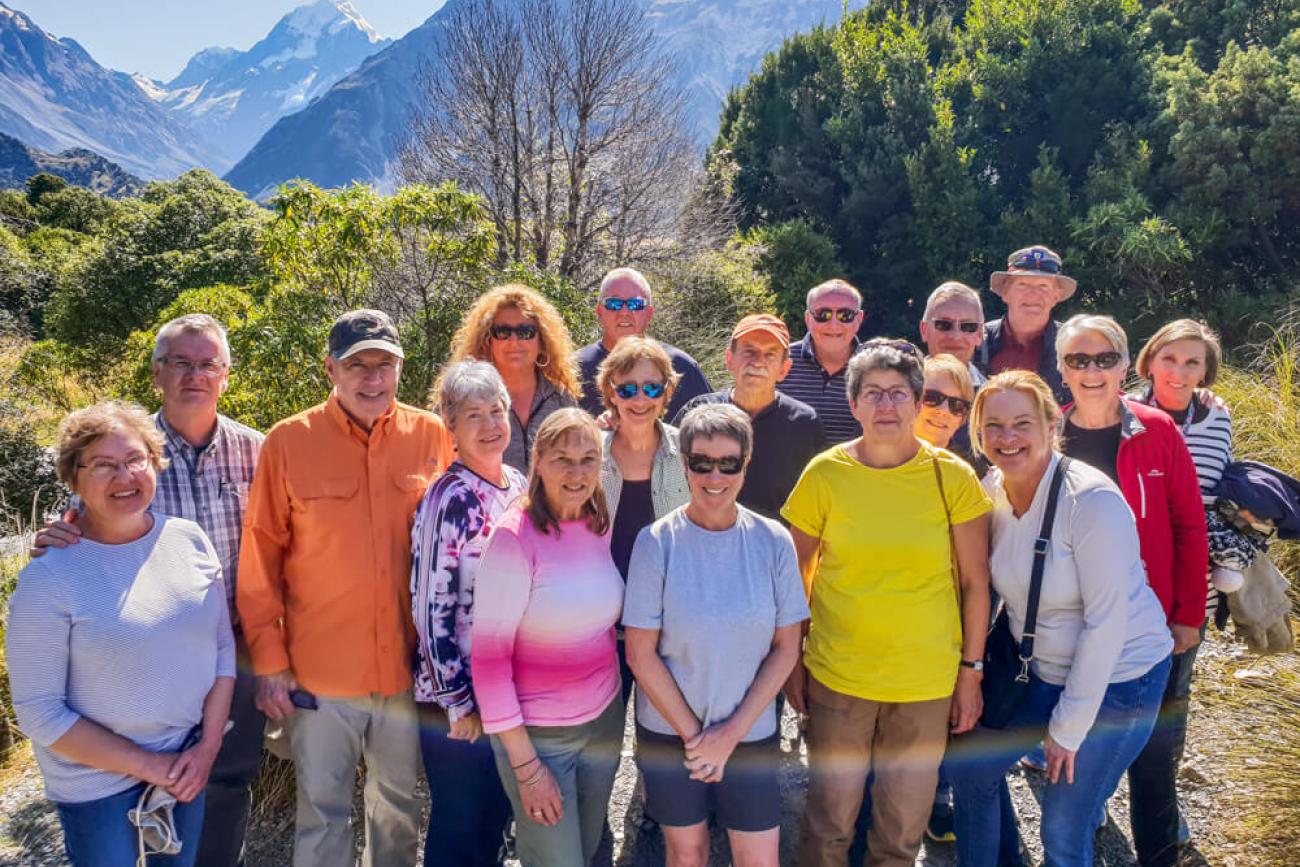
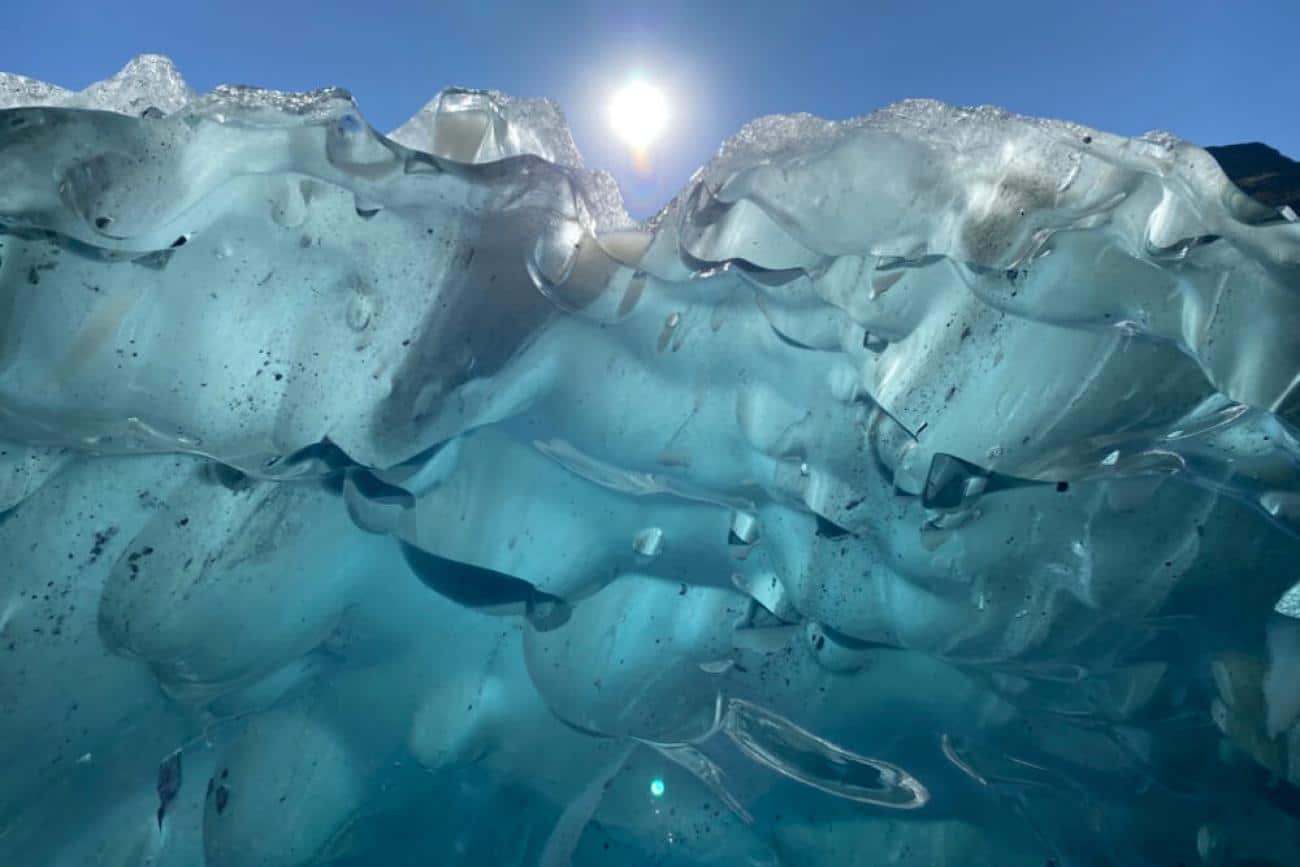
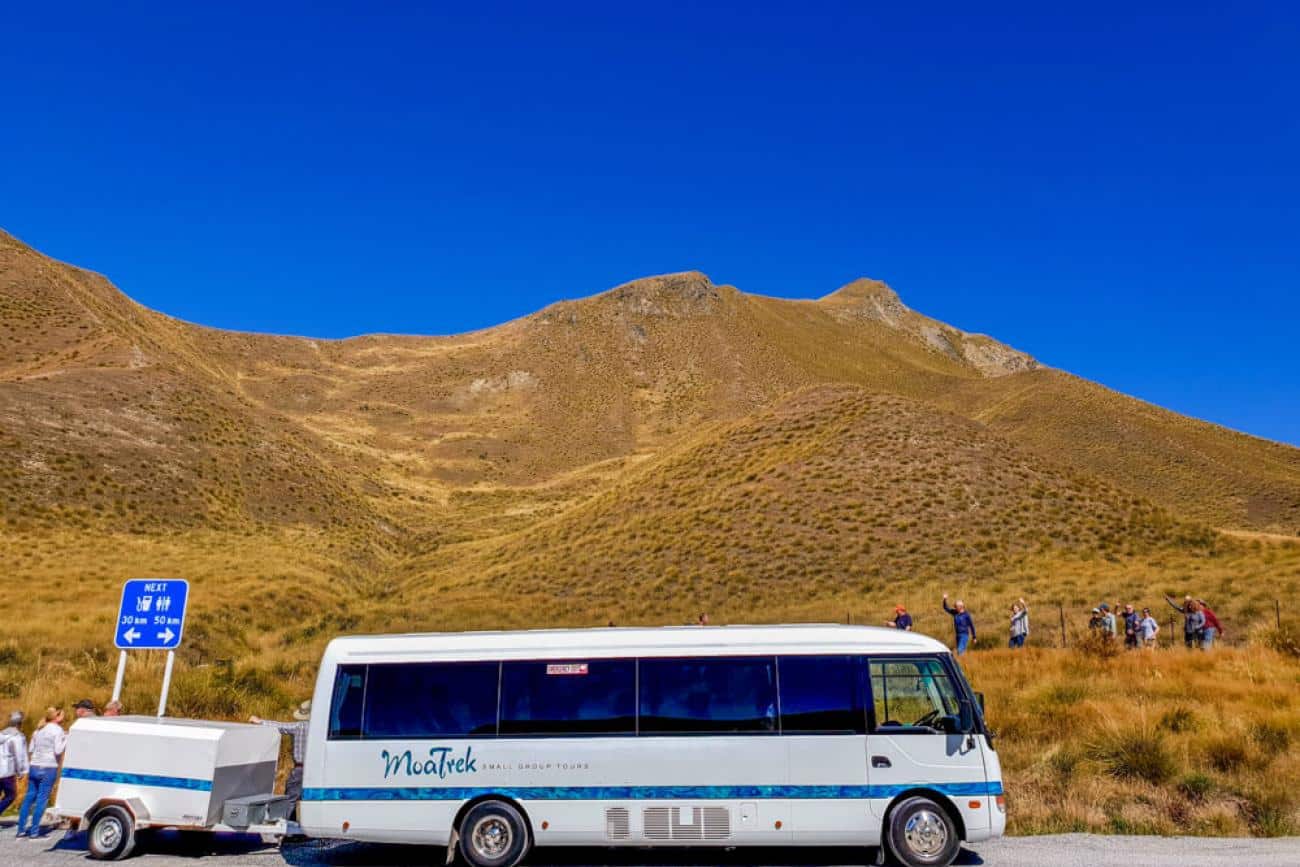
Day 3 – Milford Sound by land, sea and air
There is a saying among MoaTrek Kiwi Guides that “there is no such thing as a bad day in Milford Sound”! Despite having one of the highest rainfalls in the world with an average of seven metres per year, when it does rain (and it can be up to 250mm per day) the water cascades from the sky down the steep mountains to the sea, providing an incredible display of thousands of lacework patterned waterfalls. However, the heavy rainfall actually means there are many clear blue sky days and this is what we encountered.
The drive into Milford Sound from Queenstown is a visual highlight, the scenery changes constantly and is proof of the saying that “travelling in New Zealand, is like seeing the world in one country”. There is so much to see and so many interesting stops on the way, this really is one of the world’s best scenic drives. I always stop in the magnificent Eglinton Valley with its backdrop of the “Avenue of Disappearing Mountains” and encourage my group to “frolic”. The scenery is so inspiring that it’s only natural to link hands and skip as we sing “The Hills Are Alive…” Those who don’t frolic have an important job as well as the moment needs to be recorded by photo and video.
There are not enough superlatives to describe the boat cruise on Milford Sound, if you have not done it, it’s a bucket list must-do. We see snow-capped glacier-covered mountains dropping directly into the ocean, untouched, native forest-clad slopes with huge waterfalls dwarfed by their mountain backdrops and marine wildlife which can include whales, dolphins and seals (no guarantees of course). Combine this with the excellent, on-board guide explaining the rich natural and human history of this unique environment and it’s no wonder this is a New Zealand icon. My group’s cameras are running red hot and I am happy I reminded them to make sure their cameras were fully charged at dinner the previous night.
At the Stirling Falls, the water coming directly from the mountain glaciers above drops 155m off the cliff face into the sea and our boat is able to position itself directly under the waterfall. I never miss the opportunity for a shower, called a “Glacial Facial”, and always encourage my travellers to join me. I got there early to secure the front of the bow (the wettest) and four of my companions joined me, clad in our raincoats, for an hilarious experience, (despite having done this on many occasions, I still scream with joy every time.) Our nature guide tells us the water fell as rain 20,000 years ago and will make you look years younger. I have to say it hasn’t worked in my case despite repeated showers, but it certainly feels good drying on our faces, as we warm up inside the boat with a cup of coffee in our hands.
As if this is not enough the day just gets better. Over the years we’ve worked out the best way to experience Milford Sound and it’s something only we do, to include an amazing scenic plane flight back to Queenstown as part of our tour on the Milford Sound day. As I drove back to Queenstown having delivered my travelling friends to Milford Airport, I reflected on the time I was lucky enough to do this flight myself. I can honestly and genuinely say this was one of the highlights of my life and I know I will hear about it from my group tomorrow.
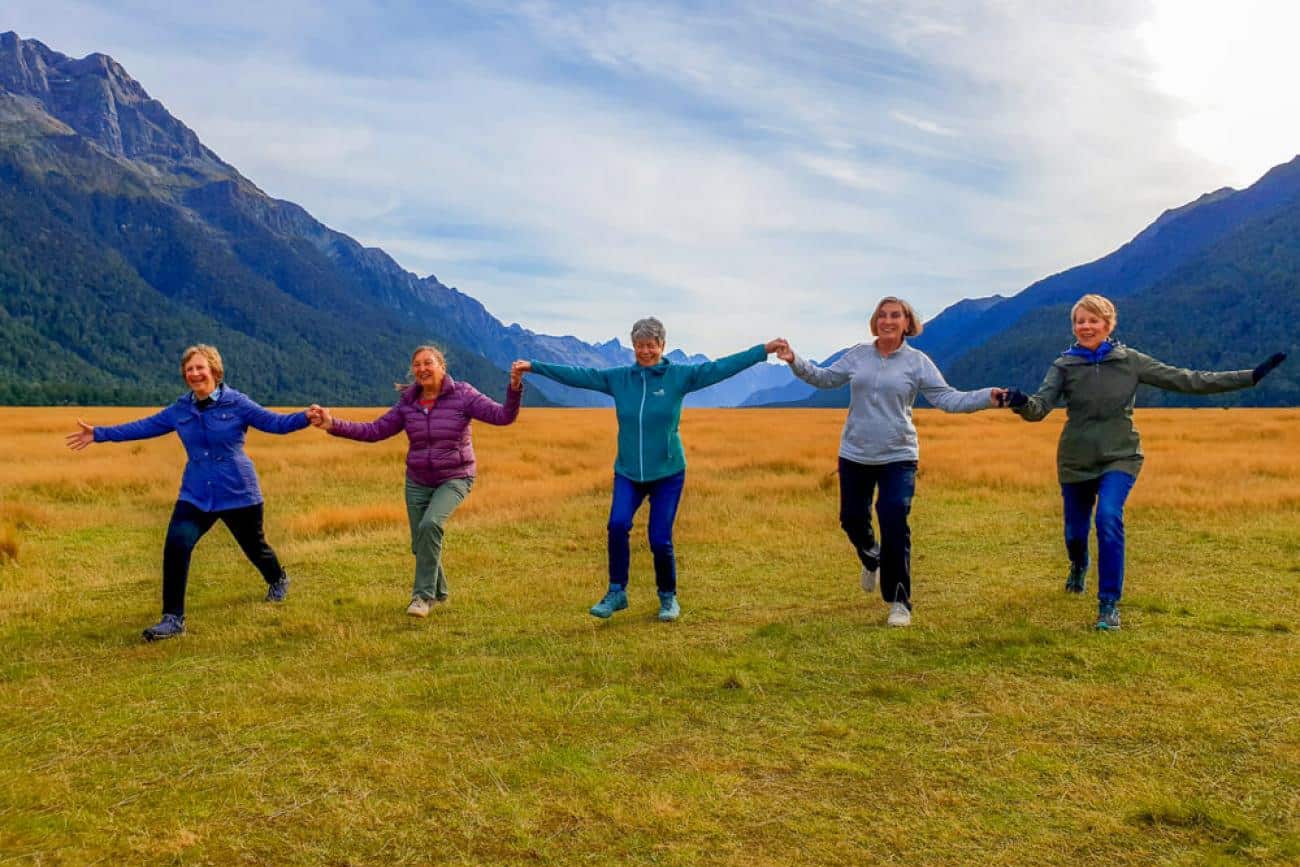
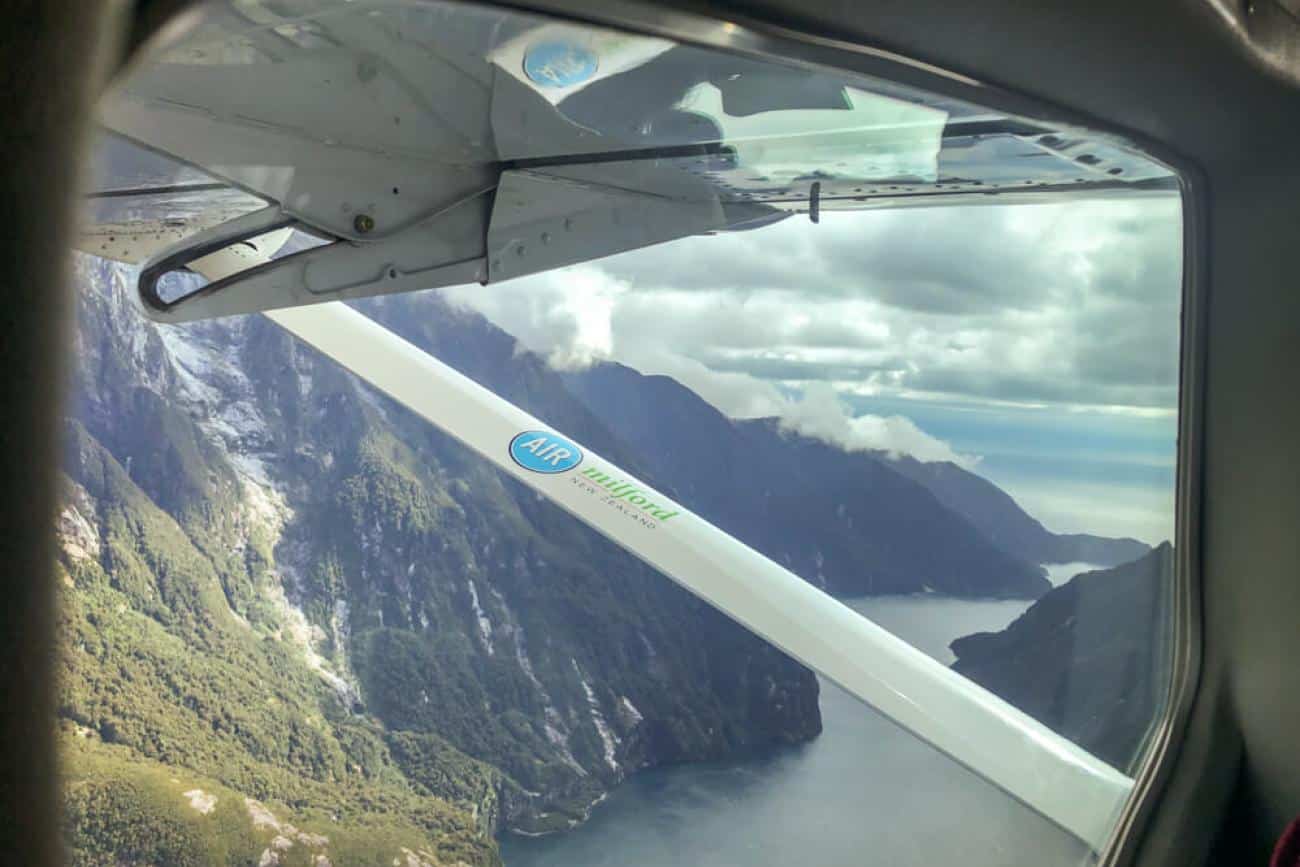
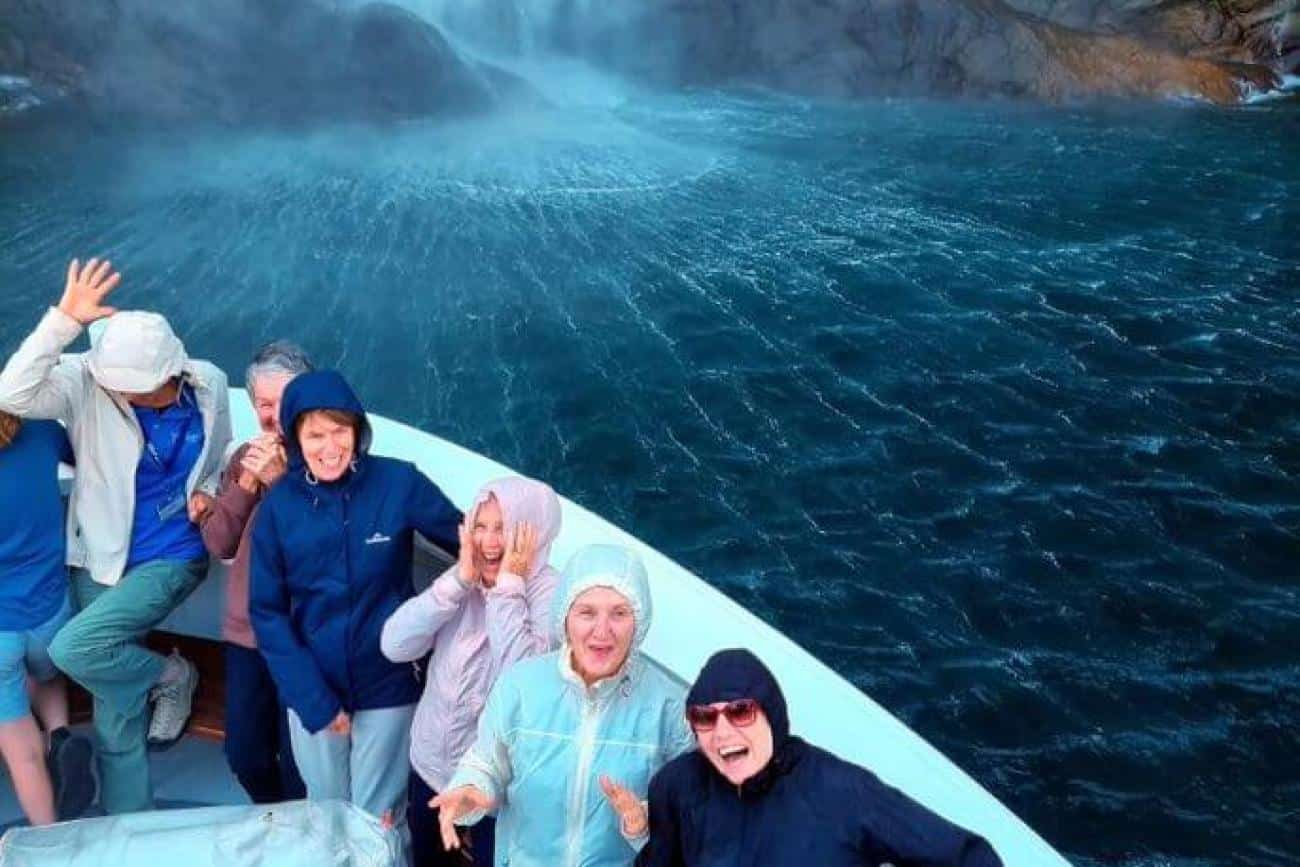
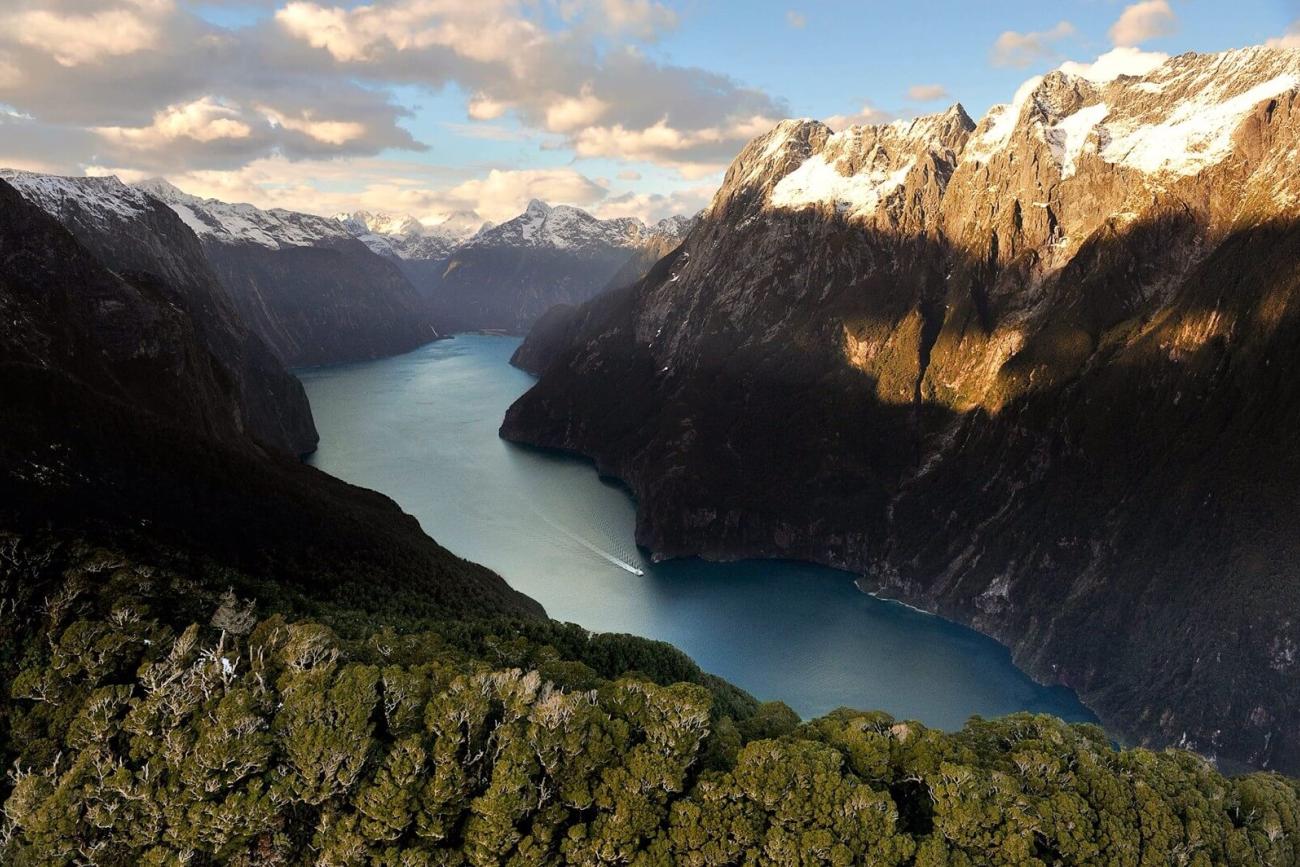
Day 4 – Explore Queenstown
Today is the chance for our travellers to relax and explore Queenstown on their own. There is a host of amazing optional activities to choose from and you’re bound to have trouble making your up your mind.
Closer to town there are wine tours to the Gibbston Valley in the heart of Central Otago’s wine region. Or an e-bike tour around the Queenstown Basin or a jet boat ride on the Kawarau and Shotover Rivers.
Further away, the Dart River Jet Boat and Wilderness Experience takes you up the lake to beautiful Glenorchy. It’s easy to see why this area has been the location for so many famous movies and television shows, as it is a real-life picture postcard. And then when you whizz up the river on the jet boat you’re heading straight into scenery from “The Lord of the Rings”. There’s another popular option too “The Lord of the Rings” tour to the famous movie locations.
Back in Queenstown another more genteel option is a cruise on the 1912 twin-screw steamer, the TSS ”Earnslaw”. Fully restored, it’s the last of a long line of coal burning steamers that were working on Lake Wakatipu from as early as 1863. The cruise takes you across picturesque Lake Wakatipu and can include a visit to Walter Peak Station for lunch or dinner before returning to Queenstown.
Among the iconic attractions are the Skyline Gondola to enjoy some amazing views of Lake Wakatipu and the Remarkable Mountain Range and learn about the Maori/European history and geology of the region. I encourage my groups to experience the luge, it’s at the top of the Gondola and is a safe (you have full control) and thrilling experience with a beautiful backdrop.
As Queenstown is small and compact it’s also a great place for checking out the boutique shops and enjoying an eclectic range of cafes, bars and restaurants.
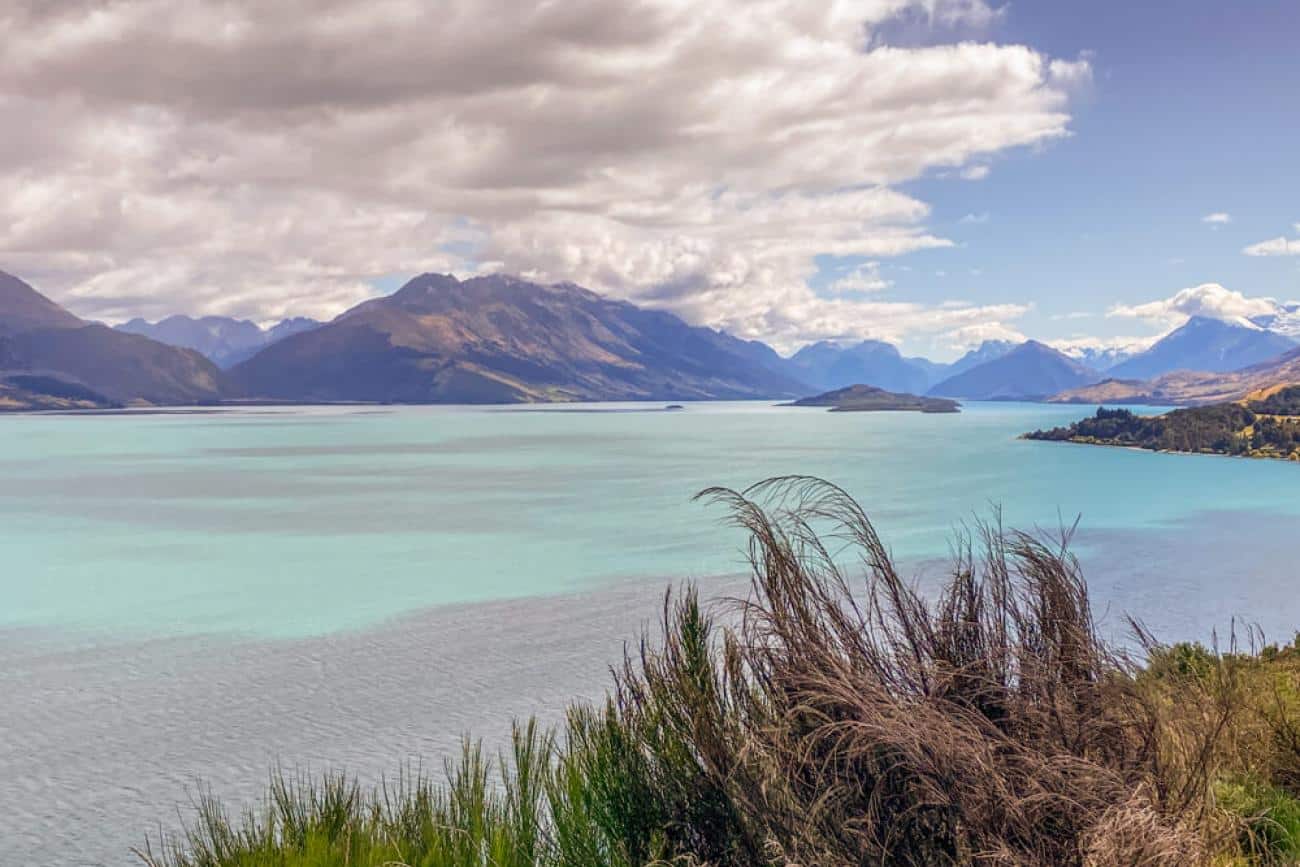
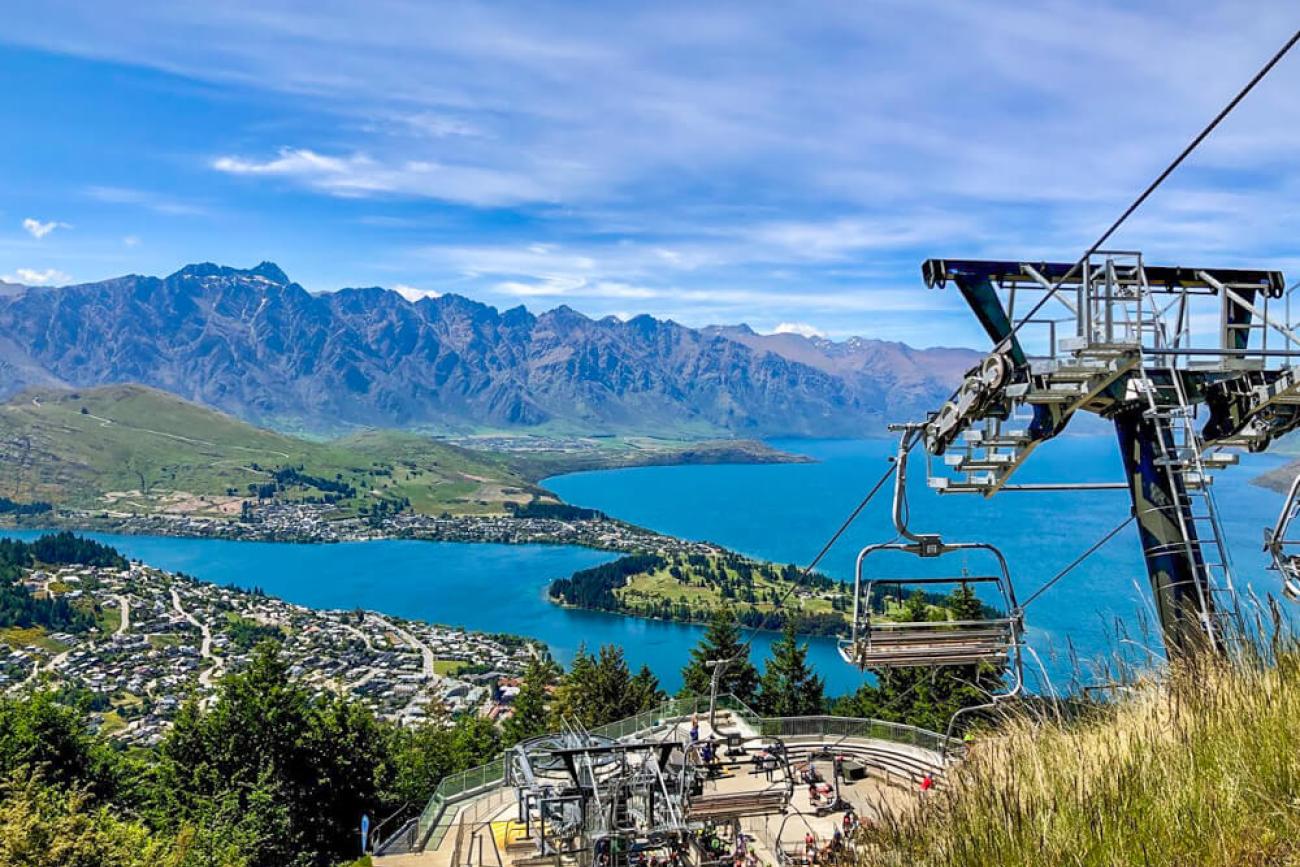
Day 5 – Queenstown – Wanaka
A relaxing day was ahead of us, with only an hour of driving and a chance to explore the lakeside village of Wanaka. Our day started with a visit to picturesque Arrowtown, steeped in gold mining history, and now a popular tourist and retirement town. The timing of our tour was perfect as the golds, reds and oranges of the autumn leaves, created an amazing backdrop to Arrowtown which still retains the look and feel of a late 19th century village.
Our first stop was my favourite café, The Chop Shop, hidden in a back alley, the coffee and baked goods are superb. Suitably refreshed we then strolled along the Arrow River, where gold was first discovered by a local shearer, Jack Tawa in 1862 and also the site of one of the most iconic scenes in “The Fellowship of the Ring” movie, when Arwen defeats the Ringwraiths after crossing the river. The walk took us to the Old Chinese Mining Village, a beautiful clearing with several tiny original miners’ cottages, it is also a reminder of an episode of New Zealand’s darker past. I have often wondered what Chinese visitors think when they read the information boards, telling of the way the early Chinese miners were treated in the late 1800s.
Next, it’s another spectacular drive as we cross the Crown Range, on New Zealand’s highest paved road. We climb easily to the summit, where we take in the spectacular views and watch planes flying below us as they land into Queenstown airport. We drop down into the Cardrona Valley and call in for refreshments at yet another New Zealand iconic place, the historic Cardrona Pub. The atmosphere is welcoming and the gardens beautiful.
The Edgewater Hotel is on the shores of Lake Wanaka, just a short walk away from the famous “Wanaka Tree”. My group all disperse to various activities, some take the nature cruise out on Lake Wanaka to walk on Mou Waho Island and others simply relax and enjoy the beauty of this lakeside town.
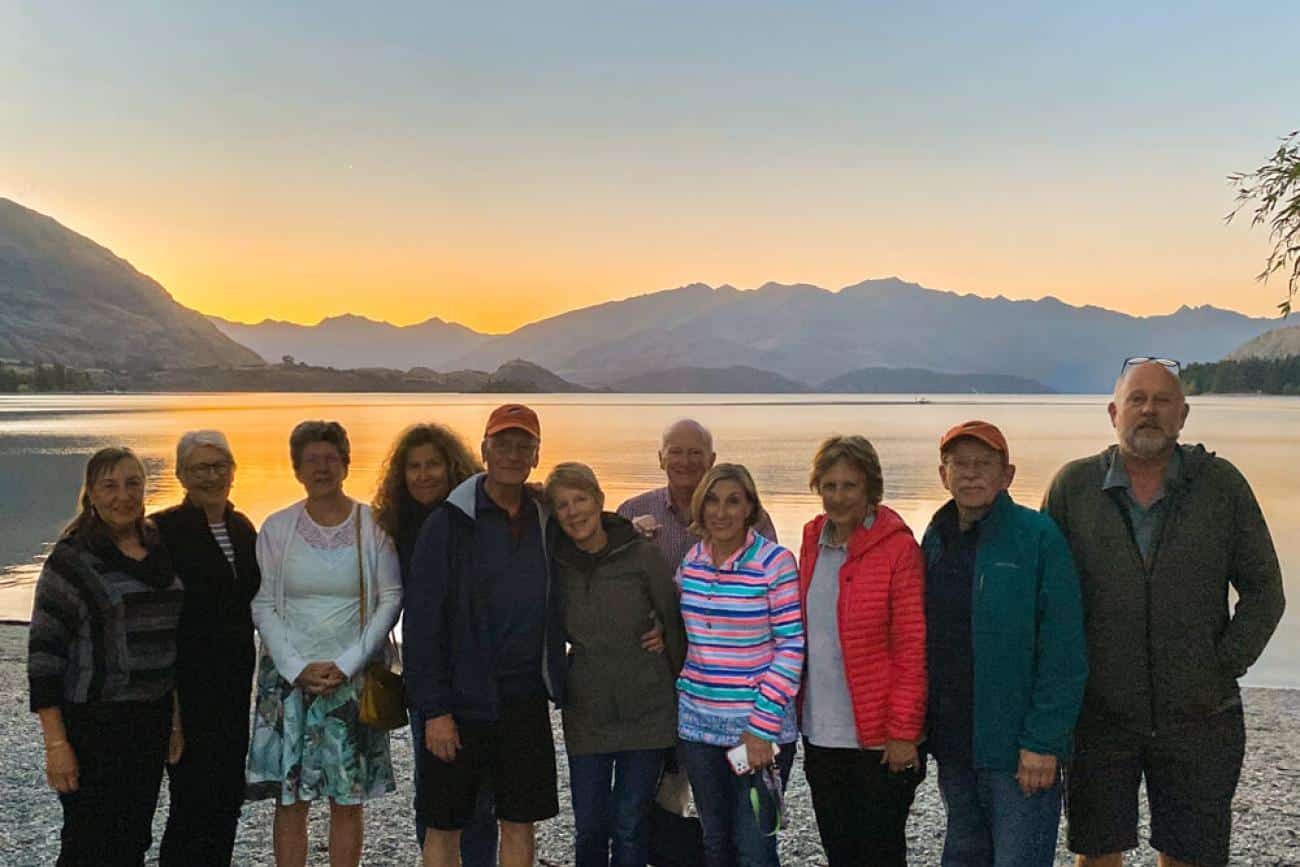
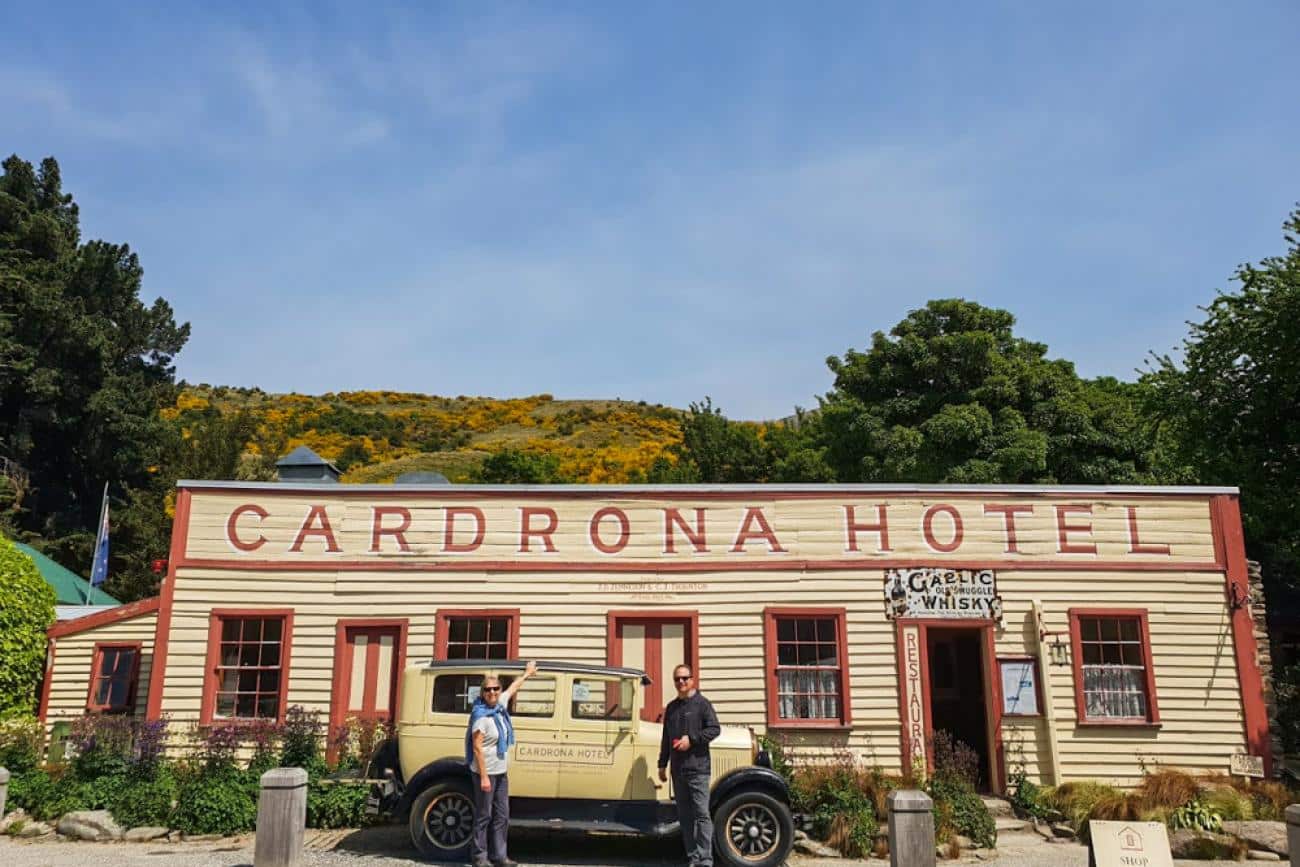
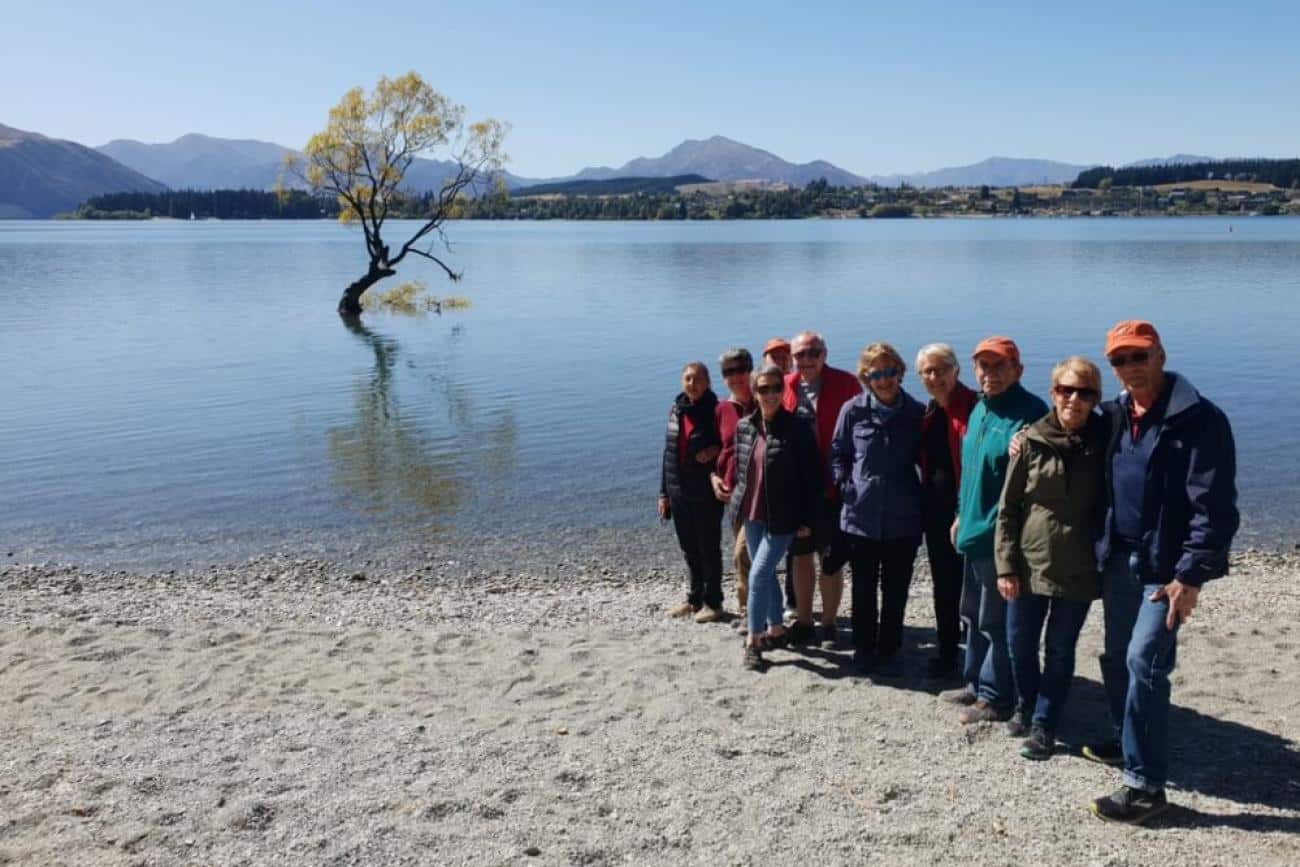
Day 6 – Wanaka – Franz Josef Glacier
The West Coast is my favourite region of New Zealand, if it was not for my family being in the North Island I would be living here now. Most of all I love the people, “Coasters” live in an isolated, wild and beautiful natural environment, which gives them a strong sense of independence, identity and community.
Our road travels between the wild and dramatic coastline, (buffeted by storms from the Tasman Sea caused by the hot air rising over the Australian land mass) and the magnificent snow-capped mountains of the Southern Alps. The lower slopes are blanketed by temperate rainforest, and bisected by aqua blue rivers dropping directly from the glaciers above.
The journey provides a continuation of amazing and ever-changing scenery, as well as stories to tell. We learn about the generational family-run high country sheep and beef cattle farms along the shores of Lakes Hawea and Wanaka, and traverse the Haast Pass to hear of the legendary explorers, Charles Cameron and Julius Von Haast. As we enter the UNESCO World Heritage protected wilderness area, I talk of the efforts of Gerry McSweeney and the Forest & Bird Society of New Zealand, who were the driving force behind stopping the logging of the old-growth native forests in the 1980s. Gerry and his wife Anne moved to the area and have been operating an Eco-Lodge at Lake Moeraki for over 30 years. There is more… whitebait, duffers (false gold rushes), weather, road construction, tourism, farming, predator control, native birds, helicopter hunters, movie locations and the origins of Air New Zealand on the Coast, are all part of our conversations.
Most of all we marvelled at the vast untouched wilderness and we had lots of photo stops and walks along the way, to be part of it. The Blue Pools walk is a hike through beautiful native Beech forest to the pristine turquoise waters of the Makarora River and, along with the Gates of Haast are incredible examples of the power of water in shaping this landscape. In the village of Haast we learned in detail of white baiting on the West Coast at the Department of Conservation Visitor Centre.
We were lucky enough to have the services of Jess, the local DOC Interpretation Ranger, as we took the short walk into the magnificent Kahikatea tree swamplands behind Ship’s Creek, and we got a glimpse of the very rare Hector’s Dolphins, as we took in the views at dramatic Bruce Bay. Our luck continued as at Lake Matheson we walked through the rainforest to a viewpoint, just in time to see the reflections of Mounts Cook and Tasman in the black lake water (caused by natural tannins leaching from the rainforest), before the clouds covered the mountains.
The rain set in as a tired but contented group made our way towards our stop for the night in Franz Josef.
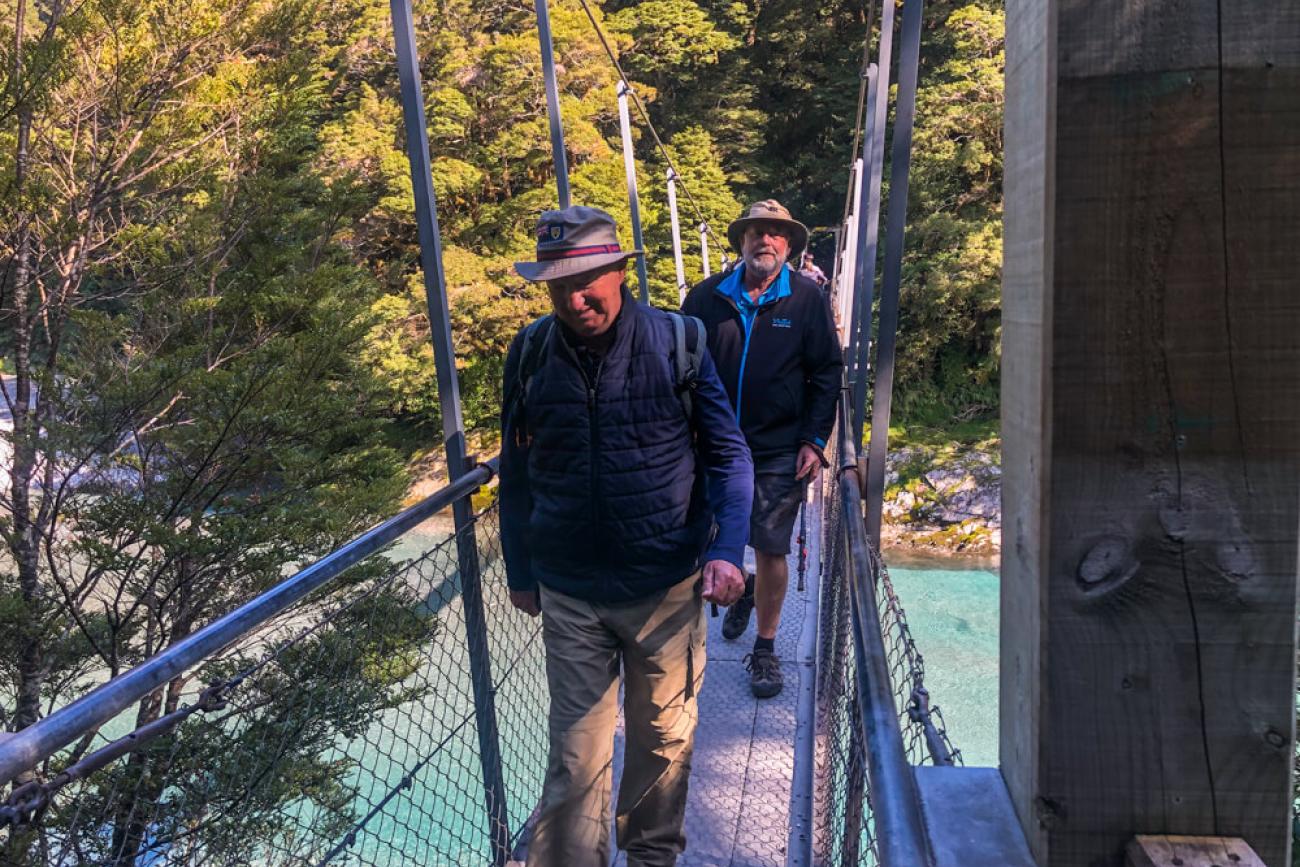
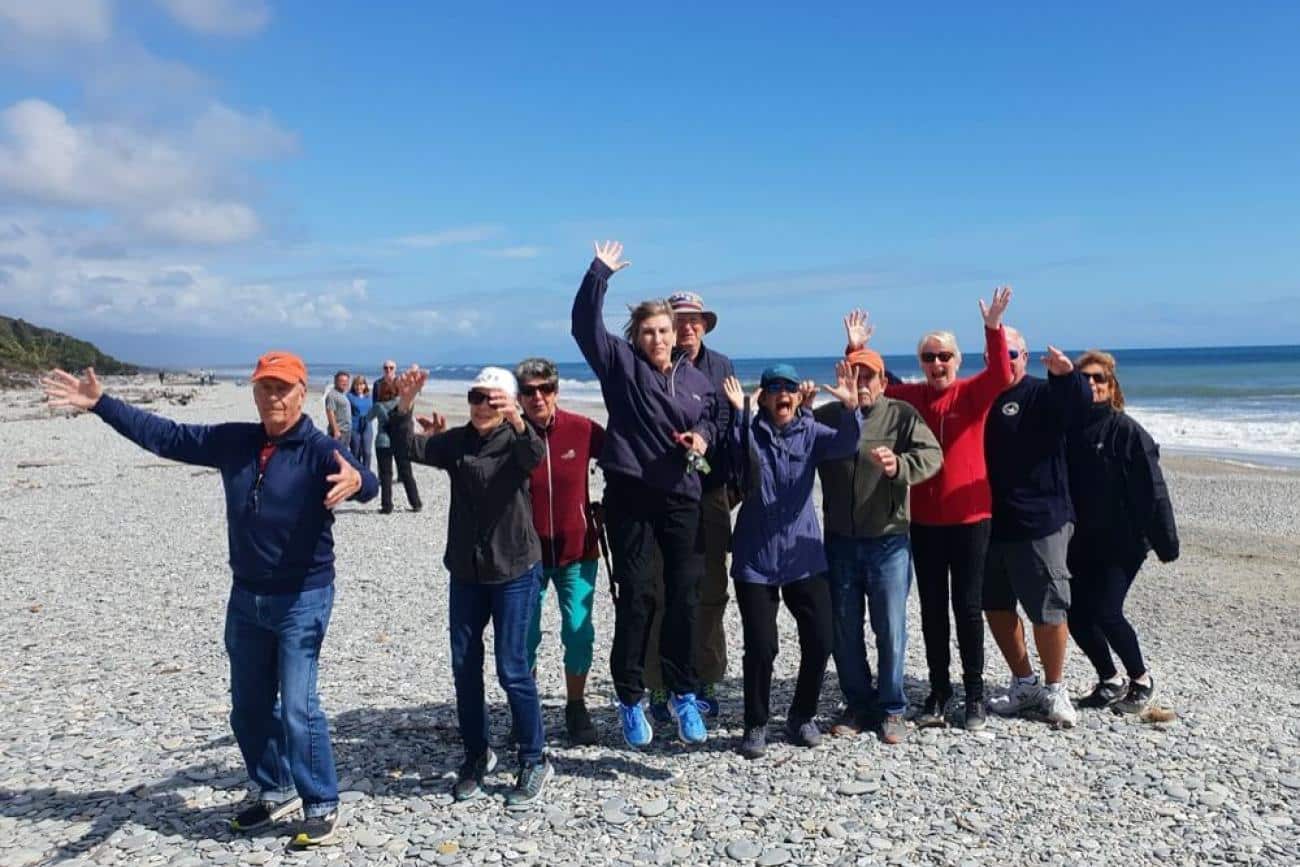
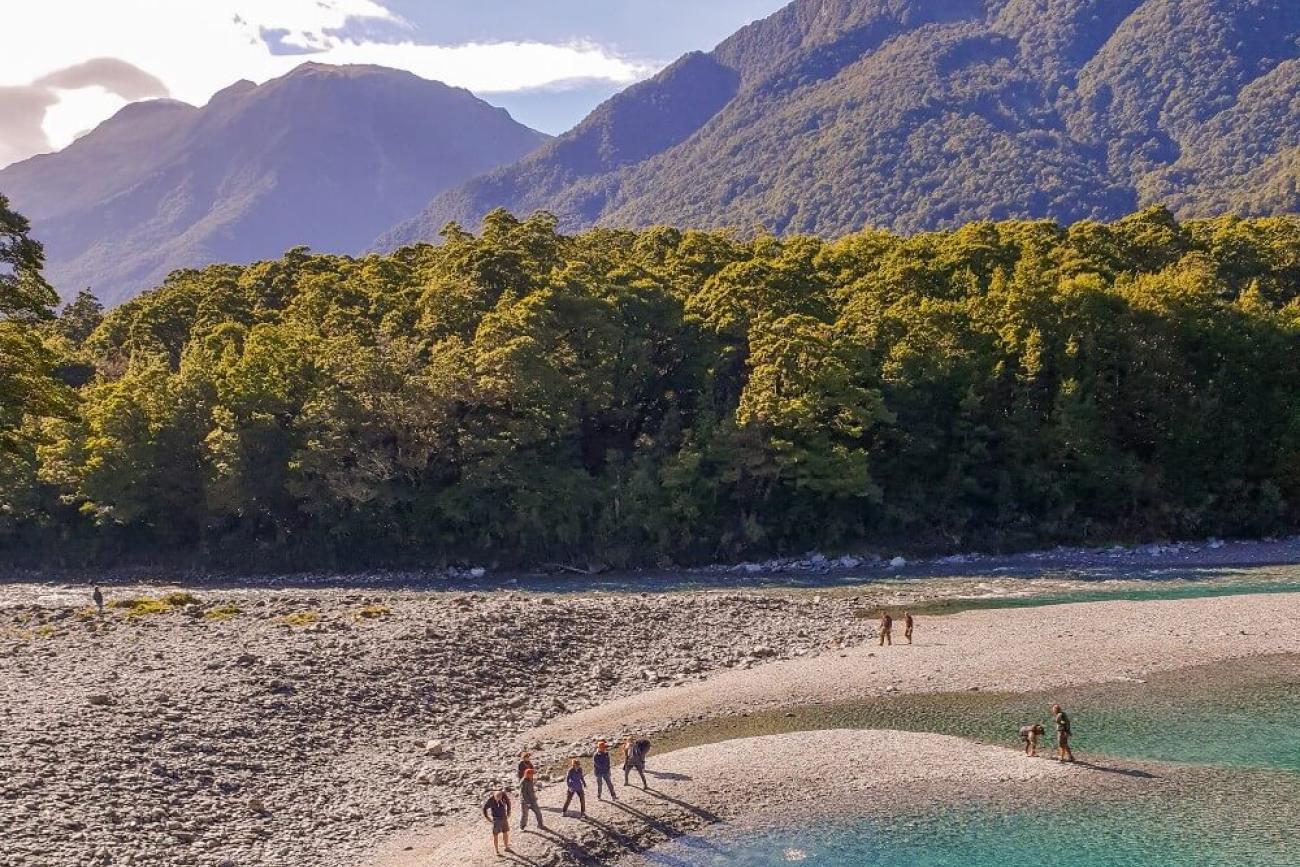
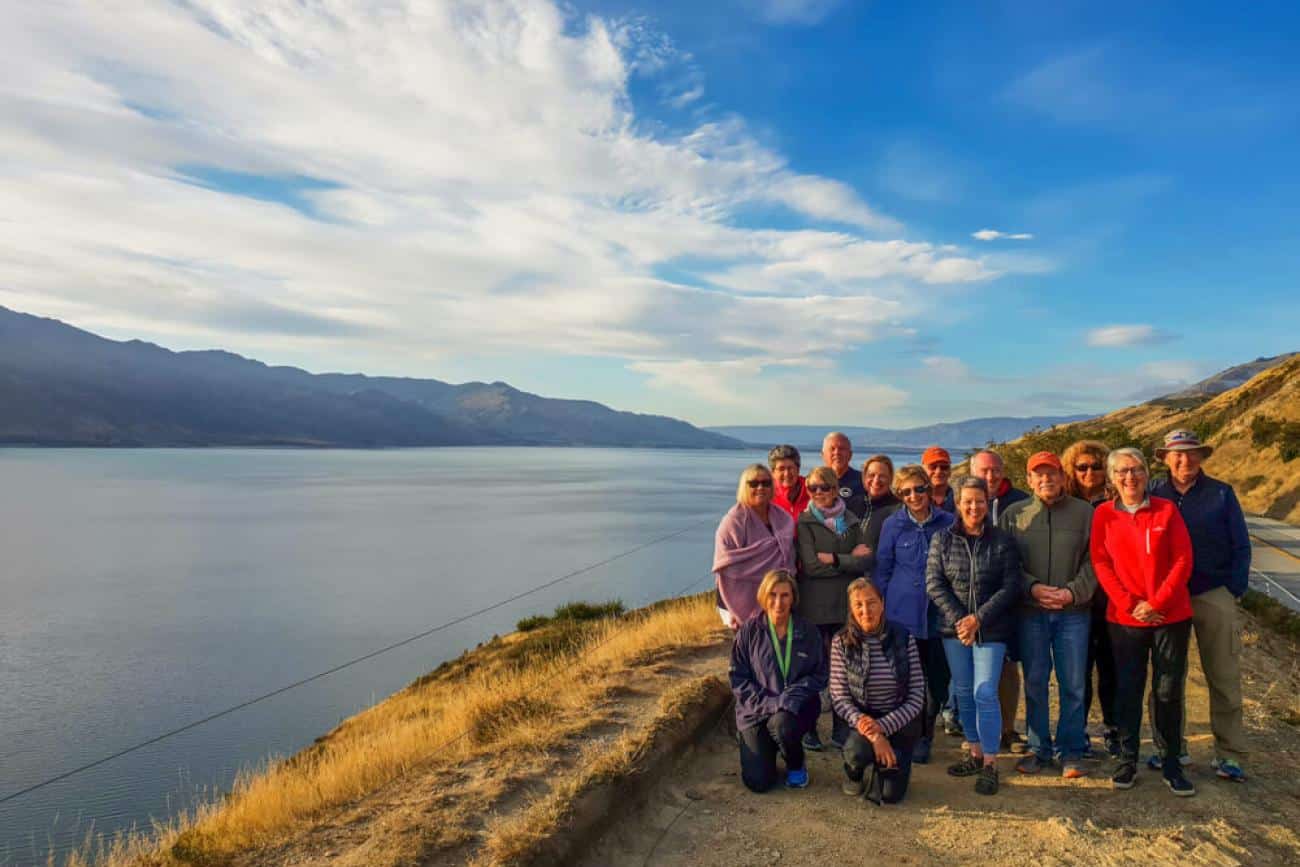
Day 7 – Franz Josef Glacier – Punakaiki
We awoke to rain, but the forecasters were correct, as it cleared by the time we left our hotel. A short drive and walk, took us to the viewpoint for the Franz Josef Glacier, and a chance encounter with Cliff, who has been guiding people on Glacier walks for 14 years. His catch phrase, “If you can’t remember my name, look around you”, rings true as we take in the magnificent glacial formed valley. The glacier may be retreating rapidly, but the vista is still breathtaking.
It’s now a clear ,blue sky morning and some of our travellers have booked optional adventures. They are excited to be taking a helicopter ride over the Glaciers while the more adventurous are heli-hiking on the glacier with a guide.
The nature lovers head out to the Okarito Lagoon, the largest unmodified wetland in New Zealand, covers 3,000 hectares of shallow open water and tidal flats and meets the beaches of the wild Tasman Sea. It’s surrounded by virgin rainforest with a stunning backdrop of the Southern Alps. The natural beauty has drawn a number of talented and creative people to live in this isolated community, including Andre Apse, one of New Zealand’s finest landscape photographers.
Swade a long term West Coast nature guide, skippers the cruise out onto the lagoon. With over 70 species of birds known to visit the lagoon, the trip is a bird watcher’s delight with rare birds to see such as the Kotuku (White Heron), Royal Spoonbill and many more. Swade shares his vast knowledge and is expert at positioning his boat at the best spot so the photographers can get the perfect shot.
We continue northwards and at Pukekura (population two) we meet with more old friends. “Possum Pete” and his lovely wife Justine are drying Sphagnum Moss, they have collected from the forest and they have a lively conversation with the team. Hunters, tourist operators, environmental activists, authors, natural clothing manufacturers and “Possum Pie” creators, they are true “West Coasters”.
If I were to live on the “Coast” it would be in Hokitika. The coastal town is surrounded by the natural beauty that typifies the West Coast and it has an interesting past. Its local rivers are New Zealand’s main source of Pounamu (Greenstone or Jade) and as such it was a very important trading centre for Maori in pre-European times. As a gold-rush boomtown in 1866 it was the most populous settlement in New Zealand with a population of more than 25,000, and boasted more than 100 pubs. Today some of New Zealand’s best Pounamu (greenstone) carvers have based themselves in the town and their presence has drawn a number of other talented craftspeople to the area. The town was the setting for the television series and Booker Prize winning novel, “The Luminaries”, by Eleanor Catton.
As we explore the town, we visit Mark (a local carver of Maori descent) and his daughter Caroline, at “Traditional Jade”, their family run Pounamu gallery. At the “Wilderness Gallery”, we meet, Jurgen and Monica, two German migrants to New Zealand, who tell the group of their journey to New Zealand, as we see one of the best collections of New Zealand made art and crafts in the country. Carol talks to us at the “Possum People”, about creating her Opossum fur clothing business and the controversial use of 1080 to control predators.
On the streets we meet Phil and Sonja, who have lived in Hokitika all their lives. Sonja runs a small guest lodge and catering business. Phil works at the local Westland Dairy Company and is a passionate local historian. He has just come back from a secret spot deep in the bush, where he measured the circumference of what he believes to be the largest Matai tree in the country. Before leaving town a visit to “Sweet Alices” is a must, for ice-creams and a chance to stock up on her delicious home-made fudge.
A very scenic hour’s drive north of Hokitika is our destination for the next two nights and one of my favourites, the Ocean View Retreat, Punakaiki.
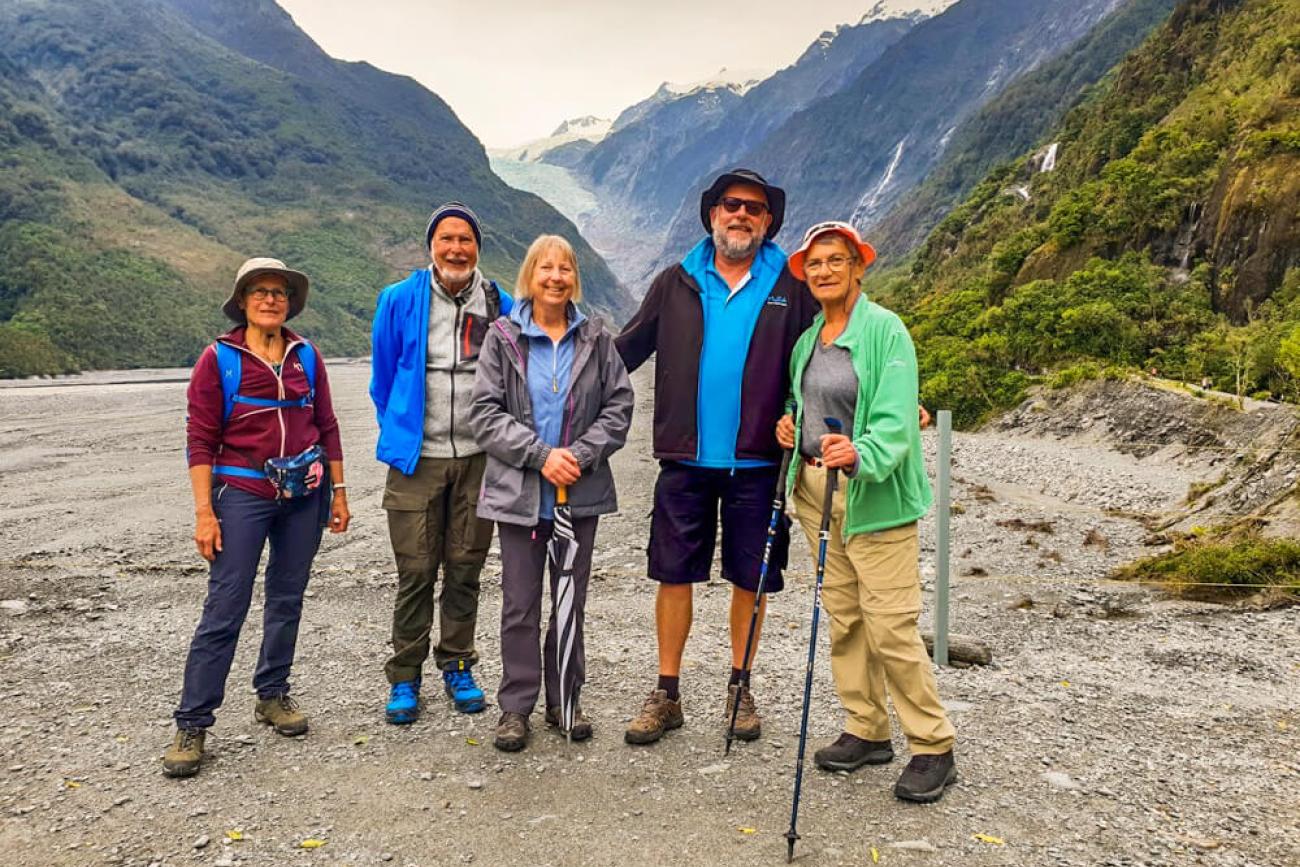
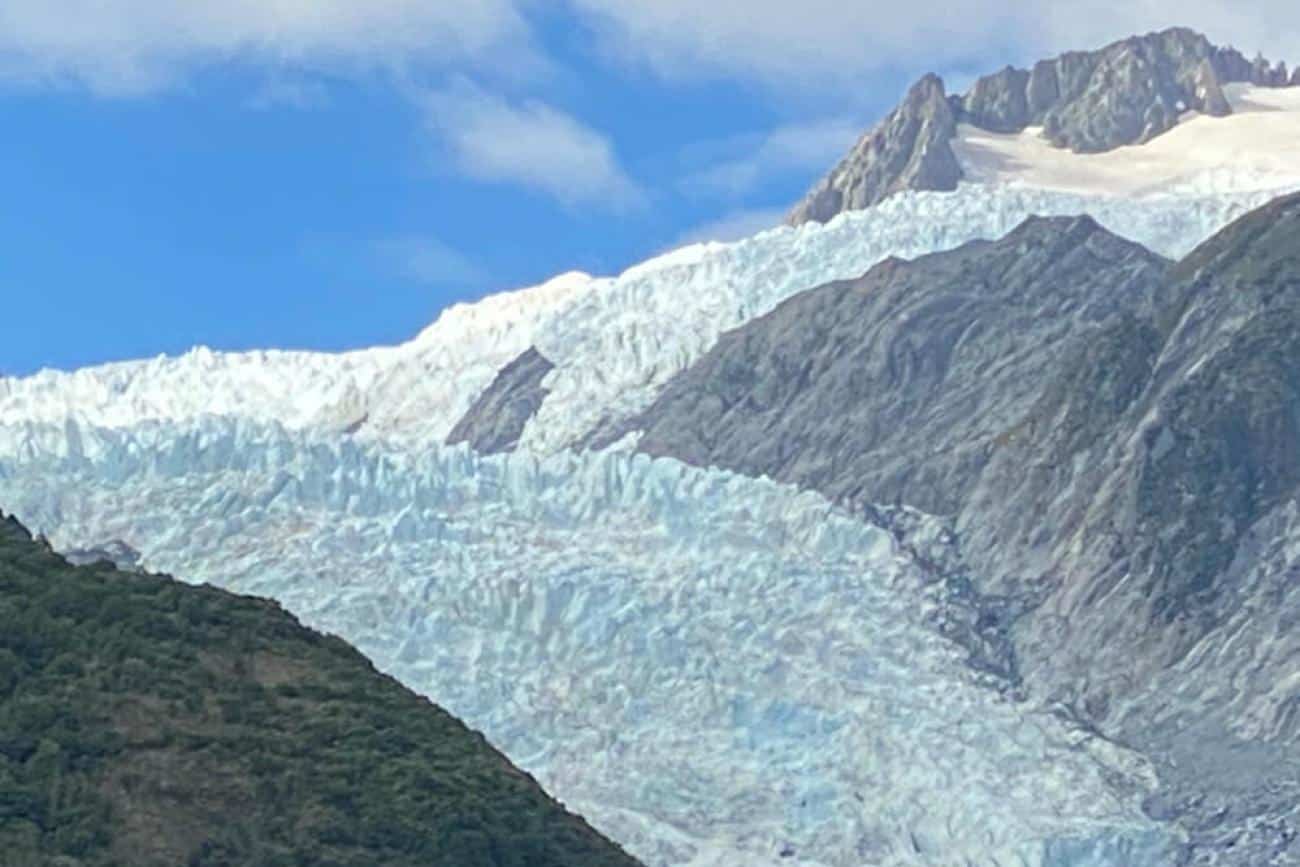
Day 8 – Explore Punakaiki, Westport and Denniston
The Ocean View Retreat is surrounded by vibrant rainforest full of native birds and with the mountains of the Paparoa National Park in the background. The comfortable rooms and restaurant have wonderful ocean views and the resort is very accessible to the Pancake Rocks and several local walks, ranging from easy to challenging. The beach in front of the hotel is known for its spectacular sunsets.
Our first stop this morning was the Pancake Rocks, where a short walk takes us to a limestone landscape of pancake-shaped rock formations, blowholes and surge pools. Formed 30 million years ago from seabed fragments of dead marine creatures and plants, water pressure caused the fragments to solidify into hard and soft layers, seismic action lifted the limestone above the seabed and rain, wind and seawater sculpted the bizarre shapes.
Next stop Charleston, there is not much to be seen now of the 11,000 gold miners who combed the area in 1867. I take the group to a nearby secret spot. We walk on the beach at the small and wild Constant Bay. It was the historic port for Charleston, and we imagine the incredible skills of the sailing ships, as waves crashed around them, while entering the narrow bay to service the gold mining settlement.
One of the things I love on our Kea Tour, is visiting out of the way and unknown places. To be a MoaTrek Kiwi Guide, you have to be a traveller at heart and, like all travellers, I get excited when I visit new places. I had read the book, “The Denniston Rose” by Jenny Patrick (highly recommended), but had never been to Denniston until my first trip with MoaTrek – it has become one of my personal highlights.
Gaining 600 metres in altitude over 10 kms, our coach comfortably climbed the paved road to the Denniston Plateau and Coalmining Historic Area, where interpretation panels present historic stories about the area. Denniston was the main township built to service the nearby coal mines and the remnants of the town and the mine remain as an evocative reminder of life on The Hill. It offers magnificent views and the remains of the Denniston Incline remind us of the incredible engineering skills of these early pioneers.
On our return to sea-level, we visited Bev Morrow at her food truck at Waimangoroa and enjoyed her delicious home-made pies and a coffee, as we sat amongst the gardens surrounded by a collection of eclectic artworks. In Westport we stocked up on essential supplies (wine for our beach bonfire tonight), before heading back to Punakaiki, the views were even better on our return journey.
Tonight Tāwhiri, the Maori weather god, was on our side as the sight of the sun setting into the Tasman Sea surrounded by a blood red sky and purple and pink clouds was spectacular. We reminisced, sang, speeches were made, and contact details swapped, a perfect way to spend our last night together.
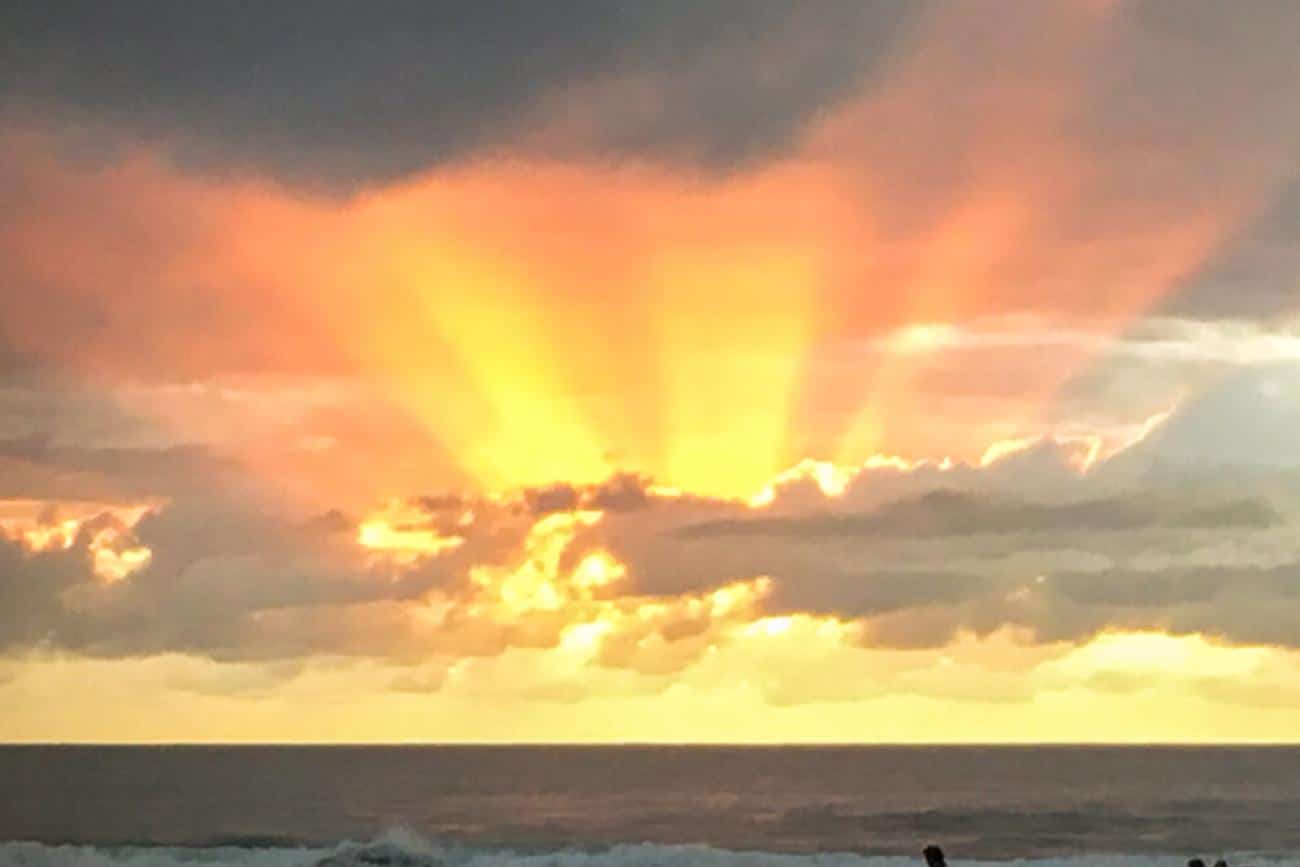
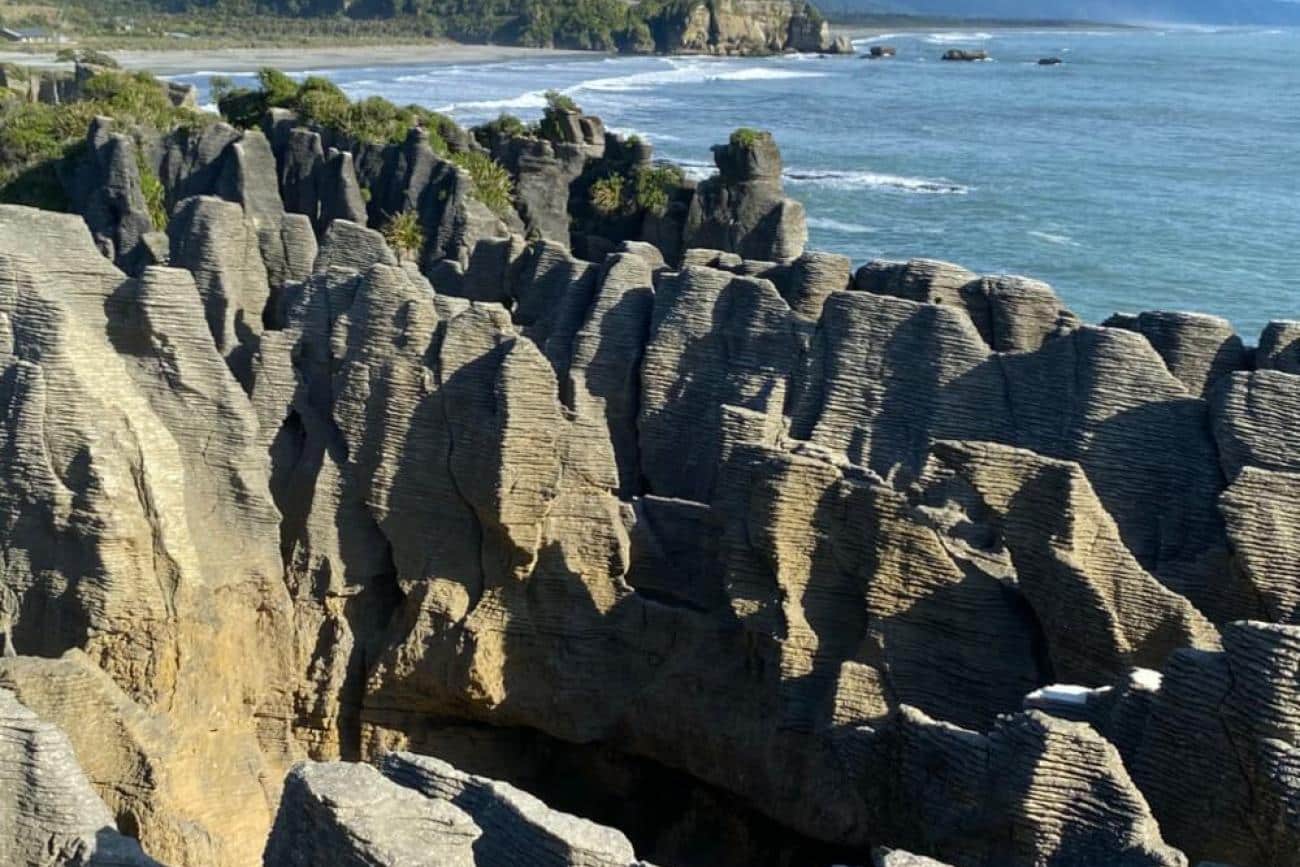
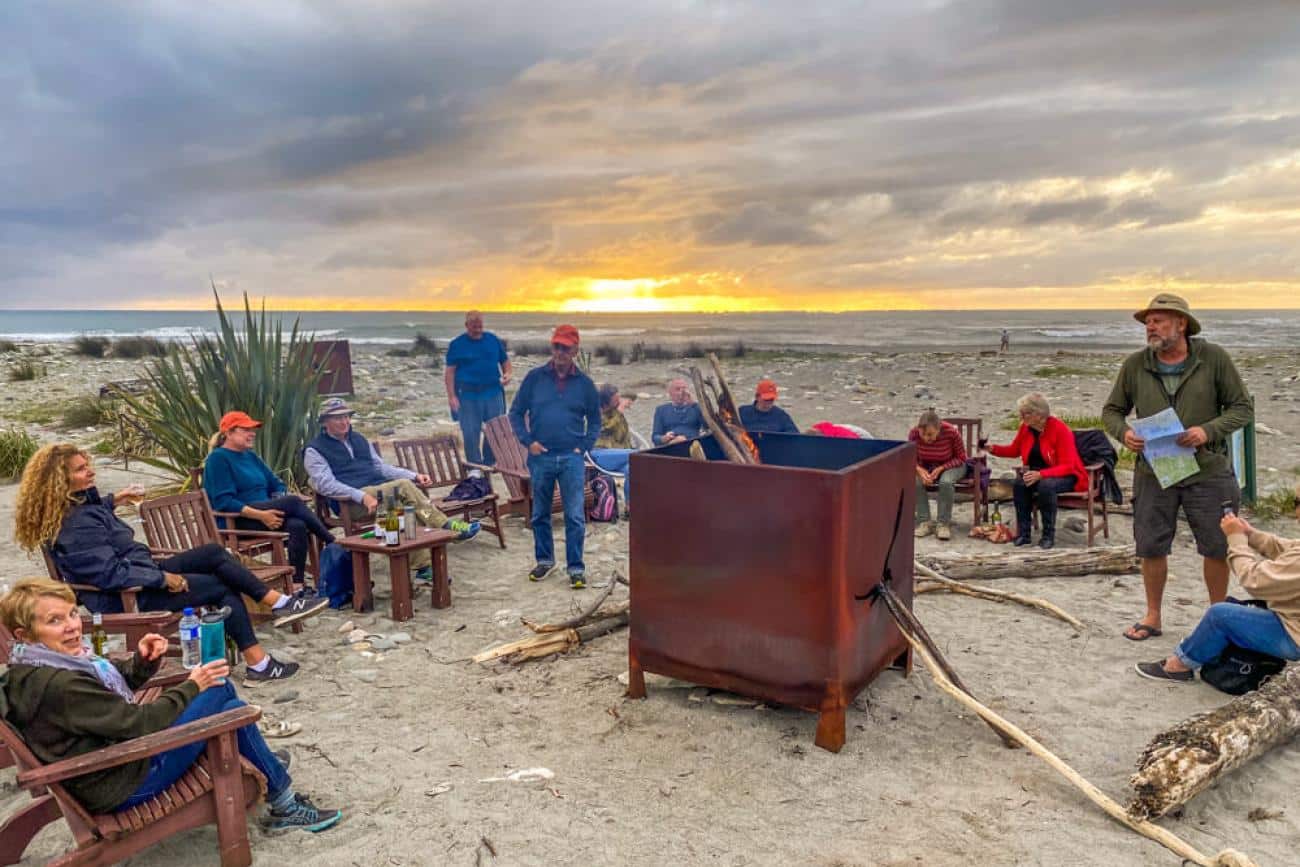
Day 9 – Punakaiki – Christchurch
We departed on a rainy day, (you do not get rainforest without rain). The grey skies set the mood for my fellow travellers, as they contemplated the end of our journey in a few hours, but I reassured them that things would get better as we crossed the mountains as the forecast was good for the eastern side of the ranges.
At Otira Stagecoach Hotel and Cafe, we met the last of our West Coast characters. I got to know Lester several years ago, when he had just purchased the run-down 1912 hotel and told me of his dream to turn it into a venue, commemorating the stagecoach era of late 19th and early 20th centuries. I have called in many times since to check on progress in the hotel restoration (which has been incredible), and to sample his excellent coffee. Lester has always been a collector of historic and quirky artifacts, and as he gives us a short talk about his vision and some of the strange things he has on display, there is lots of laughter, accompanied by “I remember these” comments.
The scenery continues to astound as we travelled over the Otira Viaduct and Arthur’s Pass. Our bus passed under the Rockfall, via a shelter to protect the road from a permanent rockslide, and at Reid’s Falls we drove under a permanent waterfall, again protected from above. The Viaduct is the most impressive bridge construction in New Zealand and leads us to the main divide and a dramatic change of scenery on the drier eastern side of the ranges. The sun is out again and at Kura Tawhiti we took an easy walk among the impressive limestone rock formations, that give the reserve its European name, Castle Hill.
As we crossed the fertile Canterbury Plains we talked of farming, water quality and the Maori and European history of the region. At Christchurch airport it’s time for sad farewells as the majority of my group fly north.
My tour ended as I completed my paperwork, cleaned the coach and put it into storage, before flying back to my home in the North Island. As always at the end of any tour, I spend time reflecting on the great people I am fortunate to meet on my tours, from the locals en route, to my fellow travellers. This was a wonderful tour, with a fabulous group of like-minded people – I love my job!
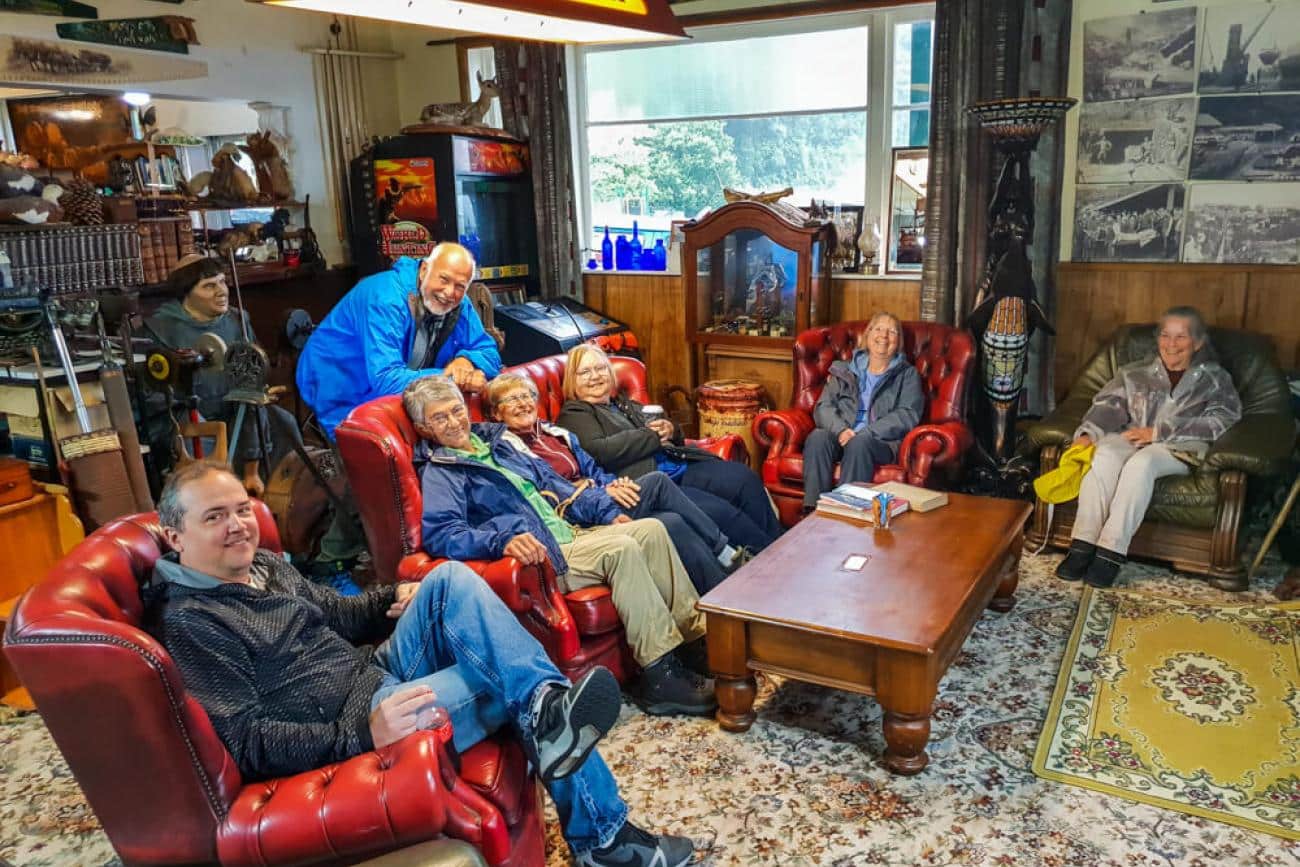
Do the trip for yourself on our Kea tour
We hope you enjoyed Tim’s stories from his travels around the South Island.
For many Kiwis visiting the icons of the South is still something yet to be ticked off the bucket list. Our 9 day Kea tour has been designed especially for people who want to see all the best spots in the South Island without having to drive and leaving all the hassle of organizing to someone else. You’ll share your adventure with a friendly group of like minded travellers led by an expert Kiwi guide, just like Tim.
More to read or watch about places in this article
Aoraki Mt Cook Travel guide for Kiwis


